Beijing TierTime Technology 3DP-12ES UP mini 2 ES User Manual
Beijing TierTime Technology Co. Ltd UP mini 2 ES
User manual
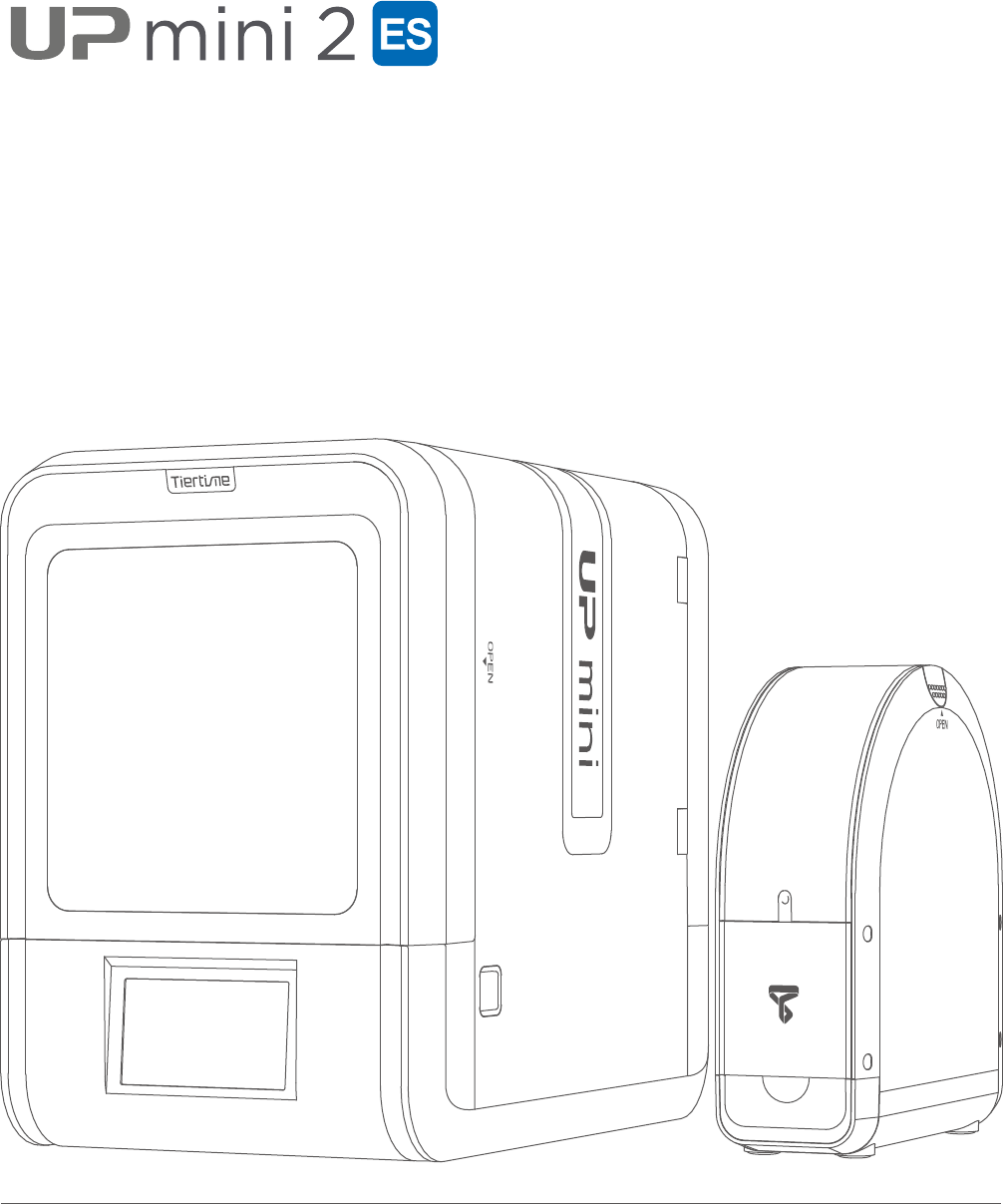
3DP-12-4J
User Manual
Download the full user manual at www.tiertime.com Support Section
Chapter 1 Product Description
Chapter 2 Prepare for Your First 3D Print
Chapter 3 Product Activation
Chapter 4 Machine Settings
Chapter 5 Print Settings
Chapter 6 Calibration and Other Options
Chapter 7 Techniques and Troubleshooting
Index
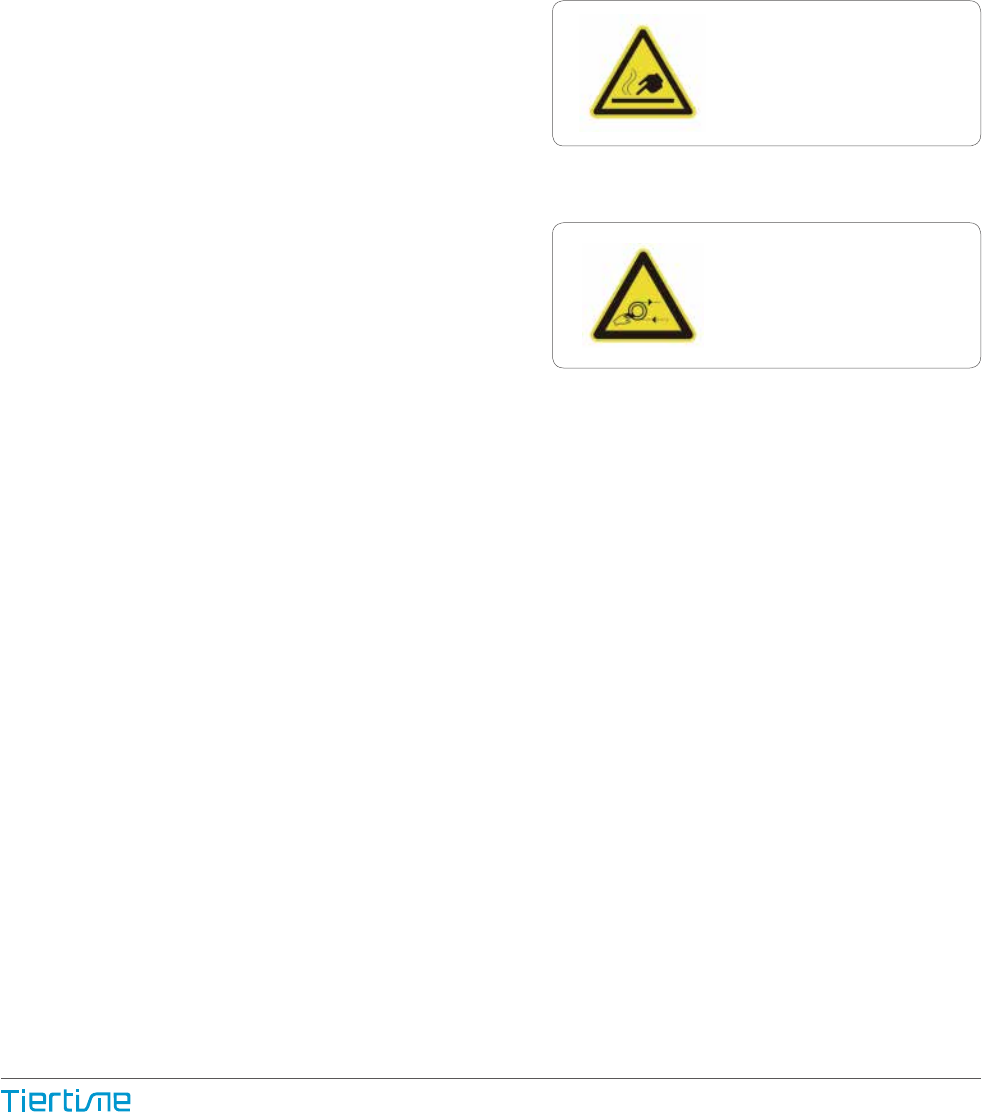
Safety Precautions
Warning label:
High Temperature,
do not touch!
Warning Label:
Moving parts, do not
touch!
Printing Environment
01
1\ The UP mini 2 ES 3D printer requires the power adapter provided by the original manufac-
turer, otherwise the machine could be damaged or even cause are hazard. Please also keep
the power adapter away from water and out of high temperature environments.
4\ Please wear goggles when removing the supporting material from models and detaching
models from the perf board.
5\ When printing with ABS and PLA, the plastics will create a light odor. Please run the printer
in a well ventilated environment. We also suggest you put the printer in an environment with
a stable temperature as unwanted cooling could cause adverse effects to the print quality.
When printer is exturding lament, make sure there is enough space between print head
nozzle and the platform. Otherwise the nozzle could be blocked.
As light odor will be produced during printing,please run the printer in a well ventilated environment.
The UP mini 2 ES's ideal working enironment is temperature between 15°C and 30°C, relative
humidity between 20–50% and altitude below 2000 meters.
Printing at temperatures out of this range could cause adverse effects to the printing process.
When using the “Extrude” function, keep at least 50mm between the nozzle and the platform.
If too close, the nozzle may get blocked.
2\ During printing, the nozzle of the printer will
reach 260°C and the print platform could reach
over 70°C. Please do not touch these parts with
your bare hands while they are hot not even
with the heat resistant gloves included with the
machine as the temperature could damage the
gloves and injure your hands.
3\ During printing, the printhead and other
mechanical parts move at high speeds. Touch-
ing these parts while they are moving could
casue injuries.
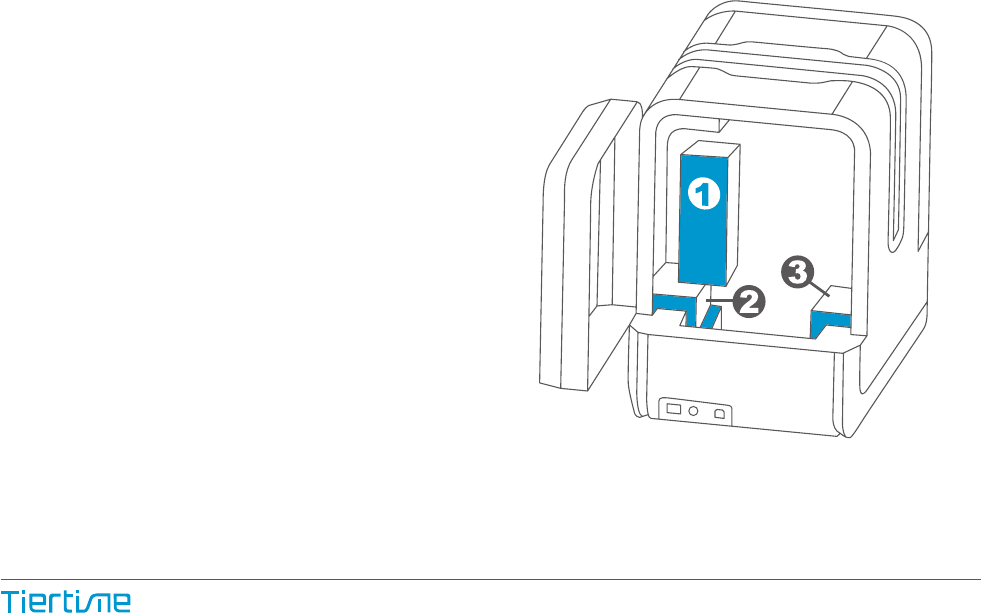
One Year Warranty
Compliance
Unpacking
Beijing Tiertime Technology Limited (Tiertime) and its authorized resellers warrants to the
original purchaser that this product is free from defects in material and workmanship.
Tiertime or its resellers will for one year, at its option, repair or replace at no charge for parts
and labor from the date you purchased the product from Tiertime or a reseller.
Remove the cushioning foams from the
inside of the machine before start using it.
• Tiertime reserves the right to determine the validity of all warranty claims.
• Consumables such as nozzles, build plates, filaments do not have warranty.
• Replacement parts such as Print head, heater module and etc, have warranty of 90 days.
• Warranty is voided if the product serial number has been altered or removed.
• Warranty is voided if the product has been misused or damaged or if evidence is present
that the product was altered, modified, or serviced by unauthorized service people.
FCC
ROHS
CE
Rear View
02
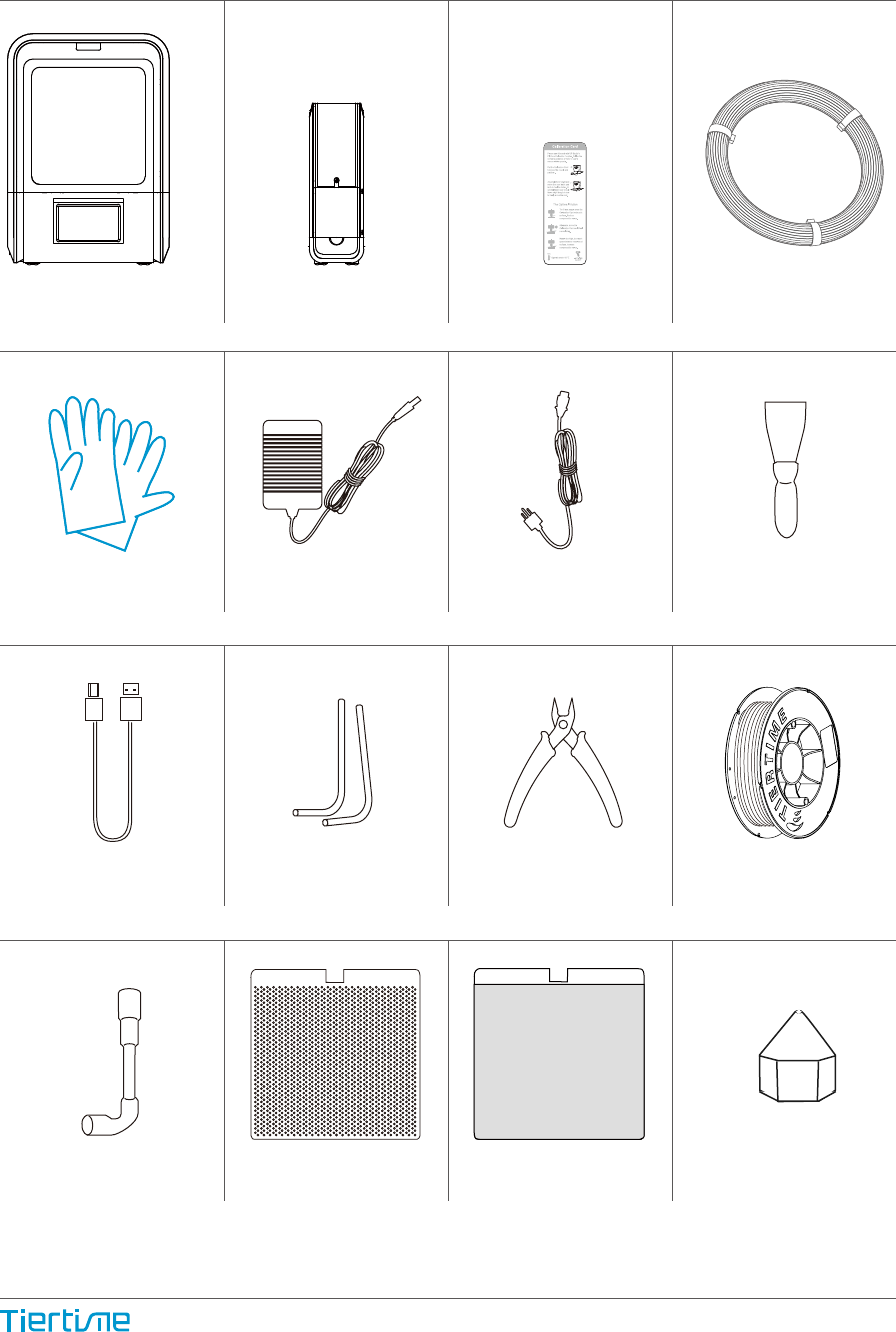
ABS Filament
Nozzle Wrench
Plier
Hex Keys
2.0mm, 2.5mm
Power Adapter
USB Cable
ScraperPower Cable
Perforated Print Board
(Perf Board) Print Head Nozzle
If anything is missing, please contact your local distributor or at support@pp3dp.com
Package Content
UP Flex Print
Board
UP mini 2 ES Spool and Toll Holder Calibration Card 50g Tester PackX3
Protective Gloves
03
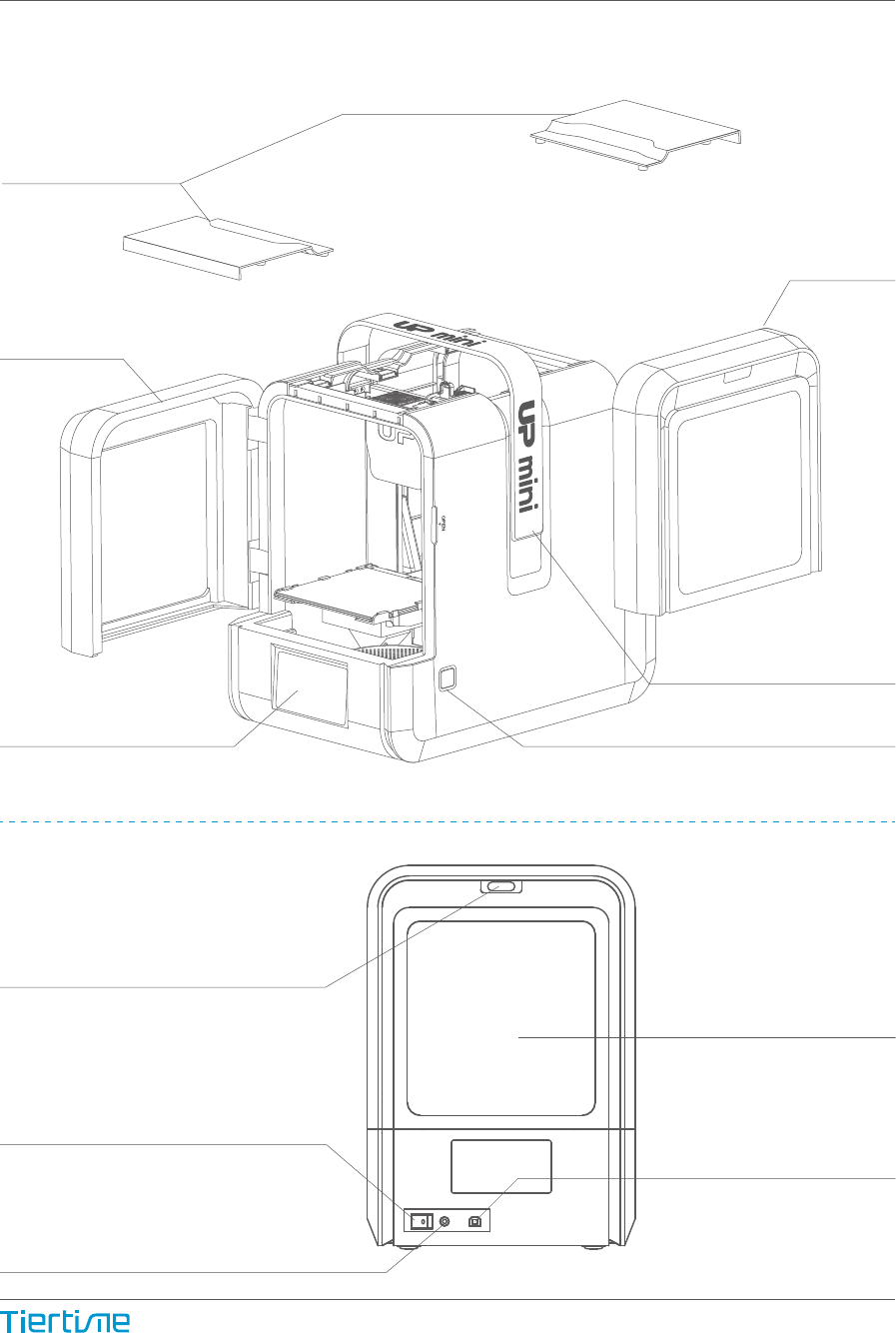
Magnetic Top Lids
Front Door
LCD Touch Screen
Back Door
Handle
Initialization Button
Front Side
Back Side
Product Description
Power Switch
Power Supply Connector
USB Connector
Back Door
Filament Insertion Hole
04
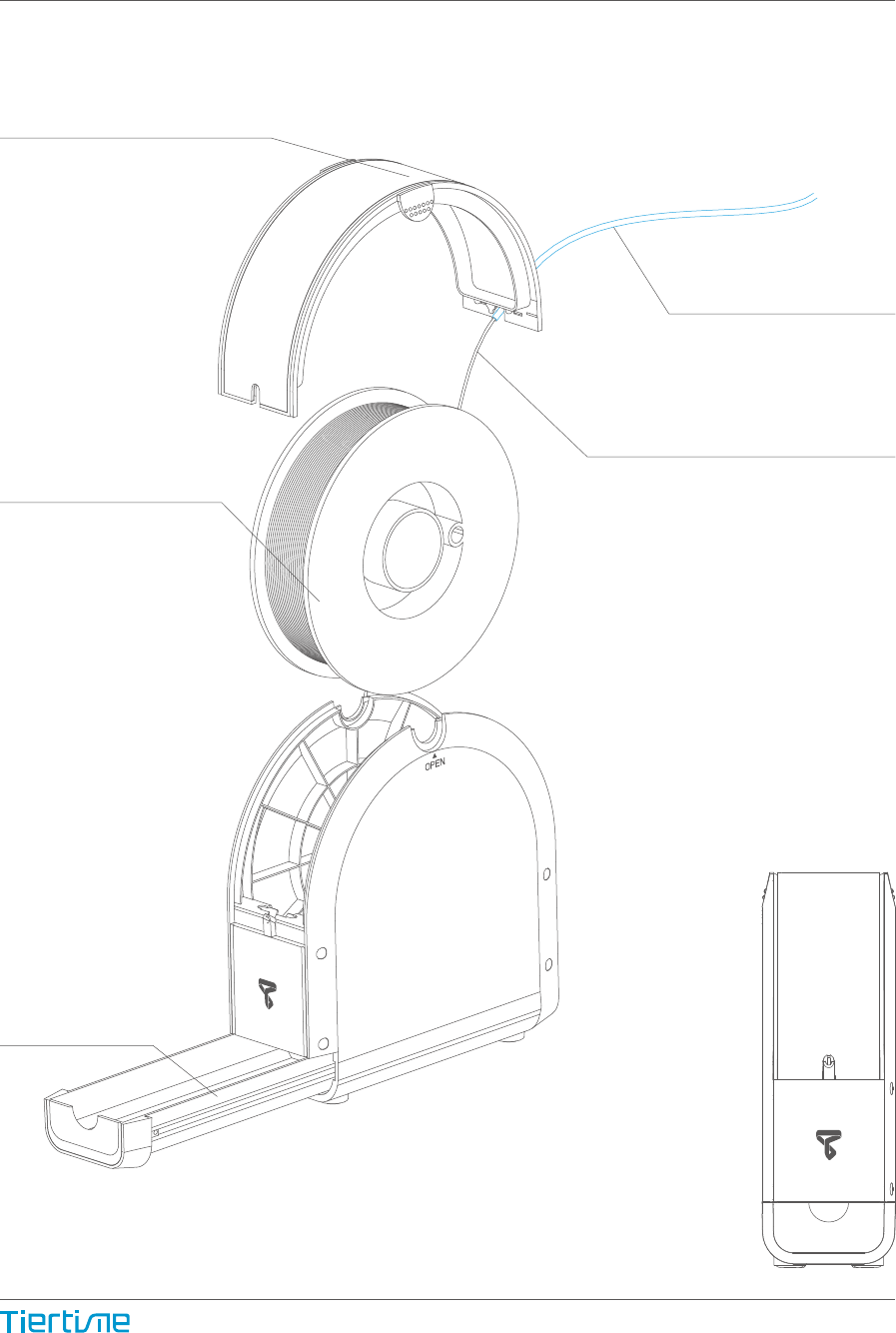
Filament Spool Holder
Spool Hold Lid
Filament Spool
Tool Drawer
Filament
Filament Guiding Tube
05
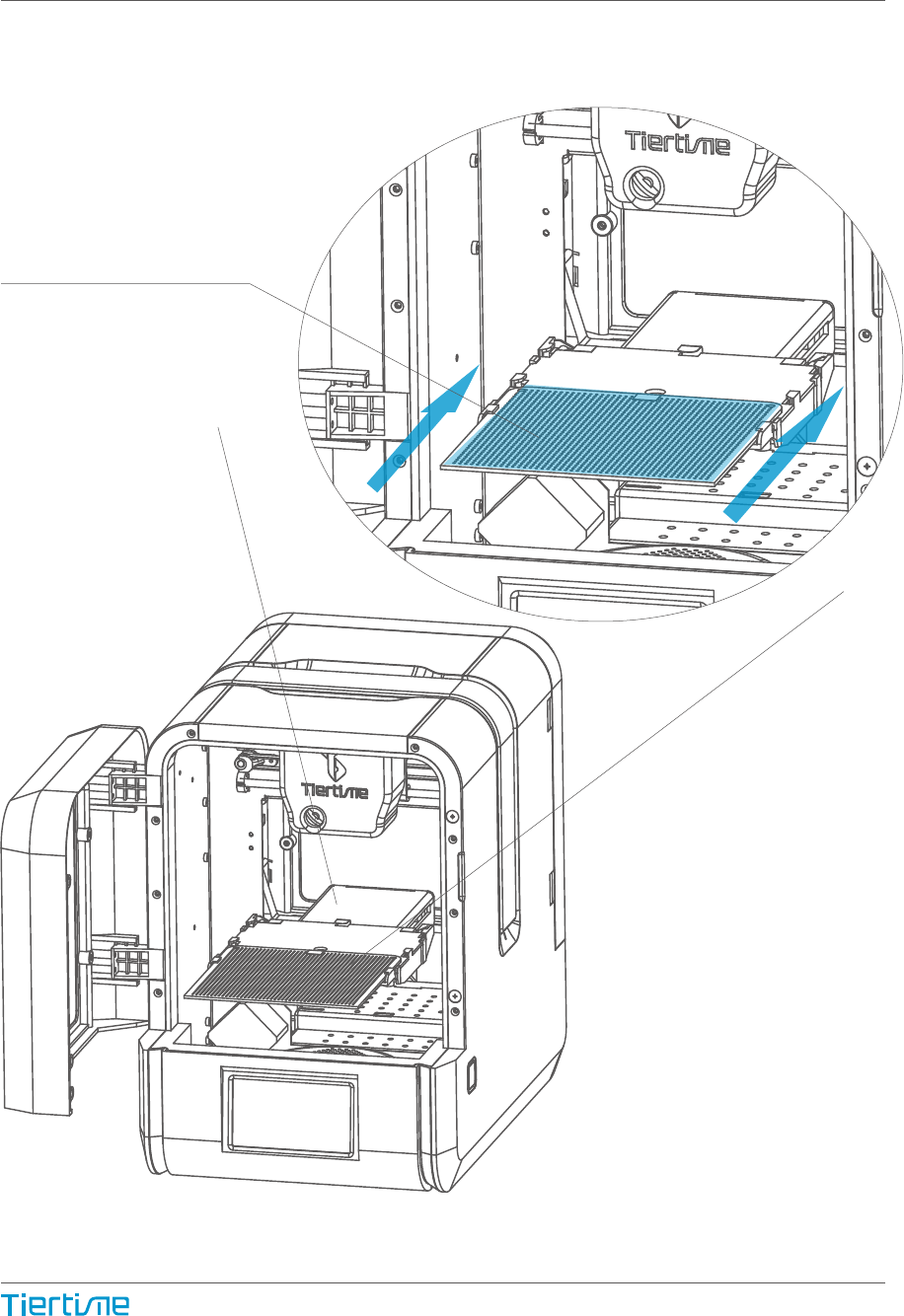
Installation of Print Board
Slide print board into the
platform
06
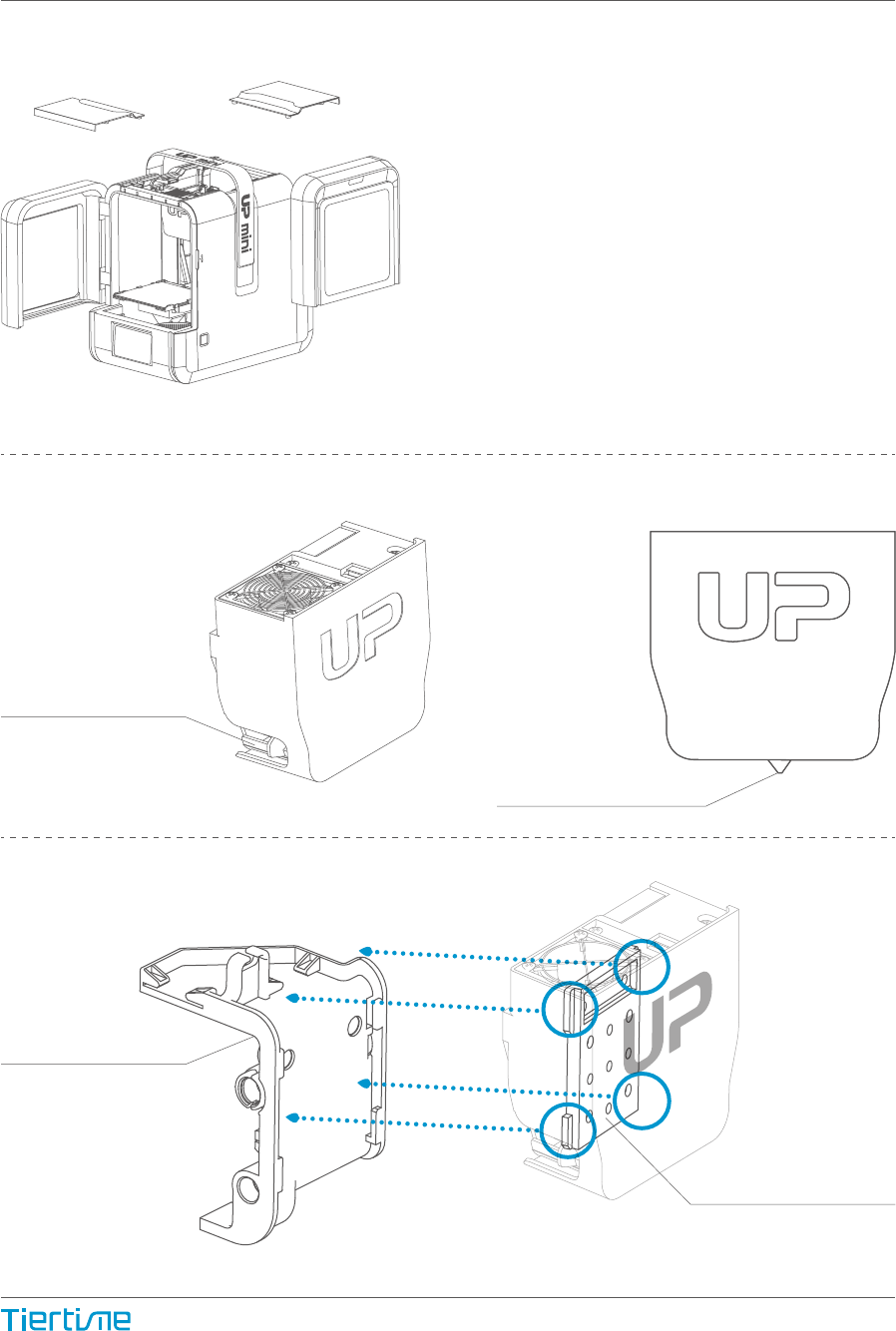
Cooling Adjustment
knob
Nozzle
Print Head Installation 2-1
Open front door, back door
and top covers
Print Head Mount
Print Head Mounting
Plate
07
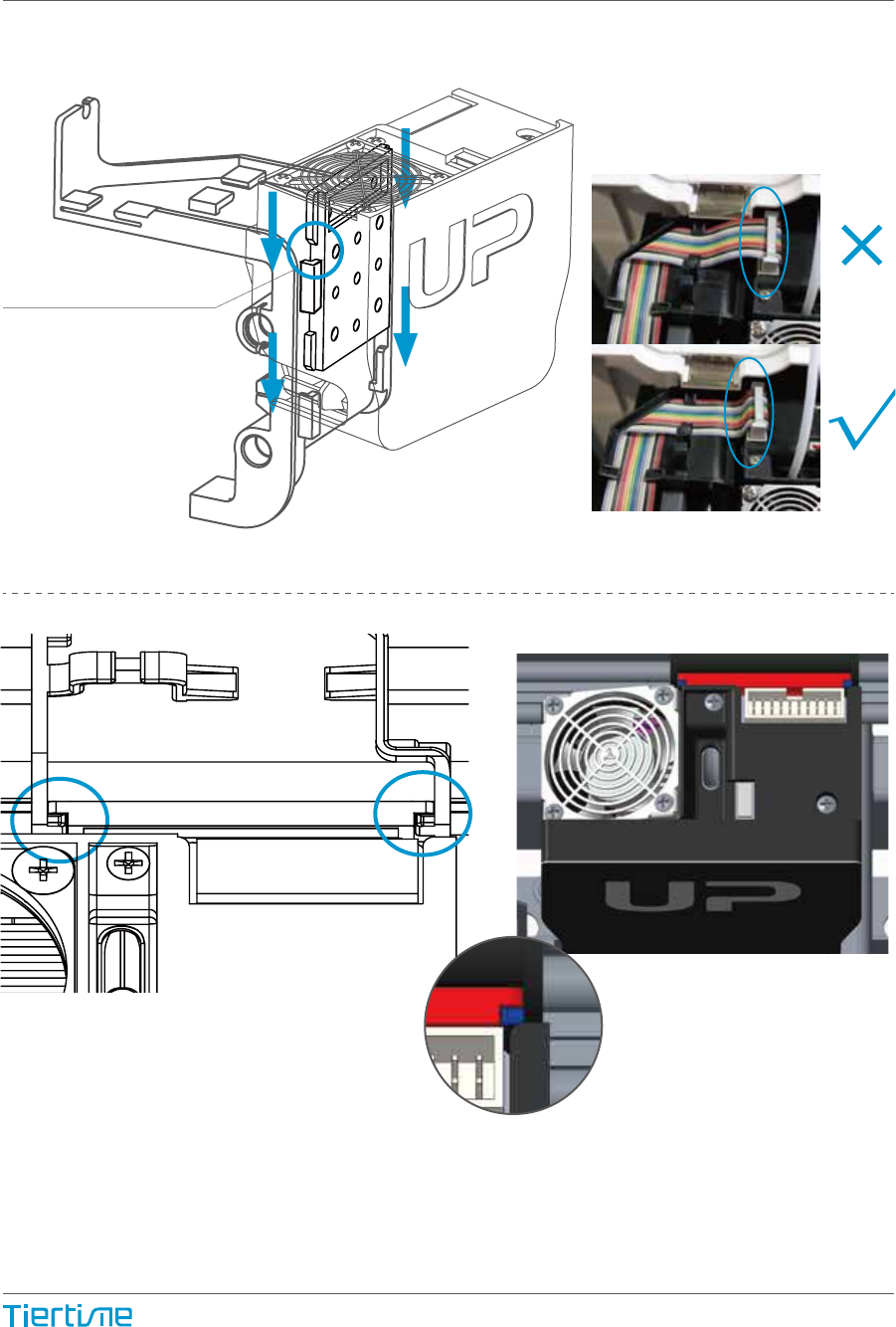
Slide the print head
into the slots.
Print Head Installation 2-2
08
The print head must be pushed
to the bottom of the mount.
Notice: when installed correctly,
the red and the blue parts should
be at the same level.
The Correct Installation about
Printhead FFC cable for UP mini 2.
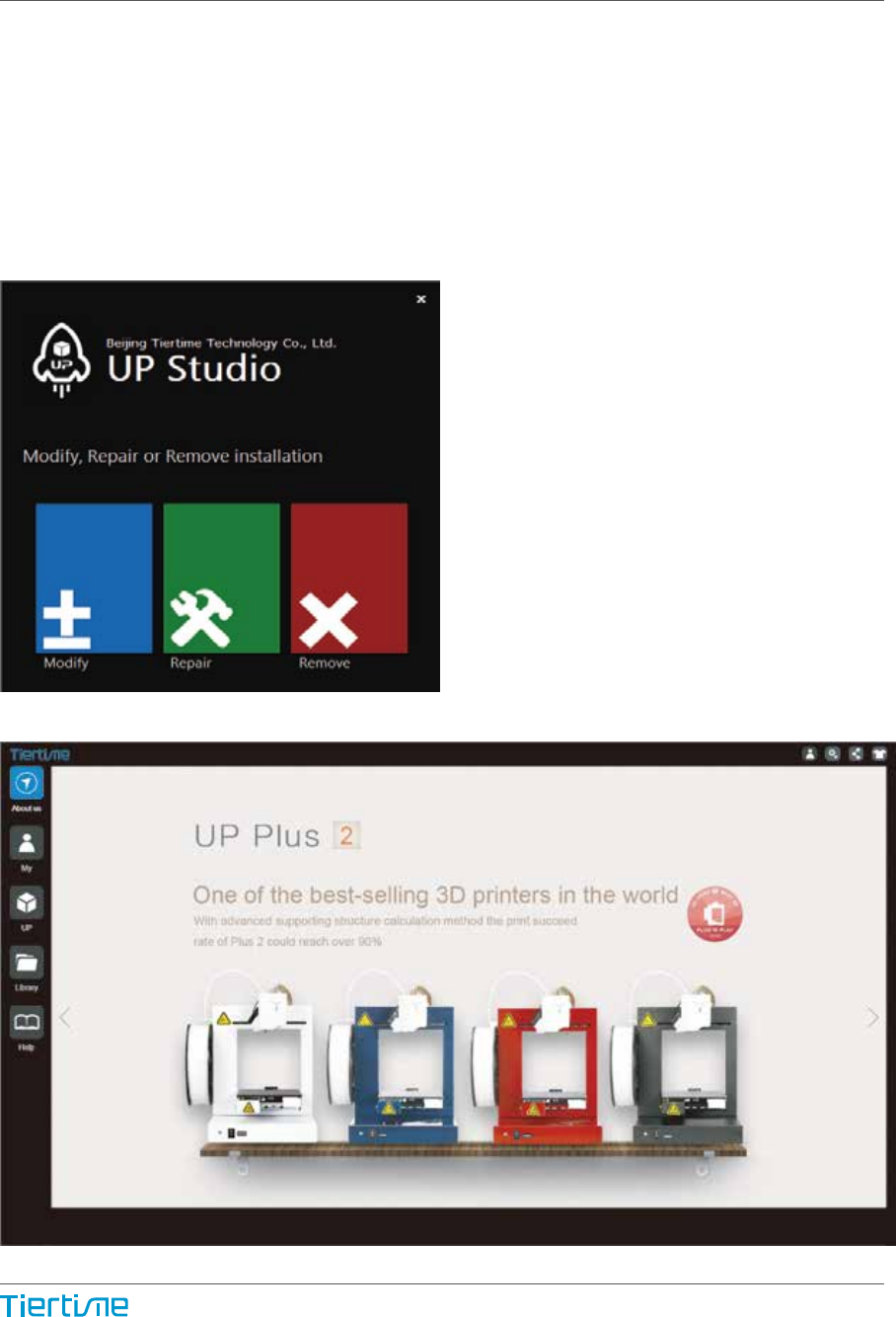
Download and Install UP Studio
Two ways to obtain UP Studio
1. From the Micro SD card included in the package (using the mciroSD reader).
2. Download the latest version from www.up3d.com.
Double click the installationle, following simple instructions, the installation will be
nished swiftly.
Minimum hardware
requirements
Intel Pentium 4 or better CPU 4GB RAM
Display card support OpenGL 2.0
09
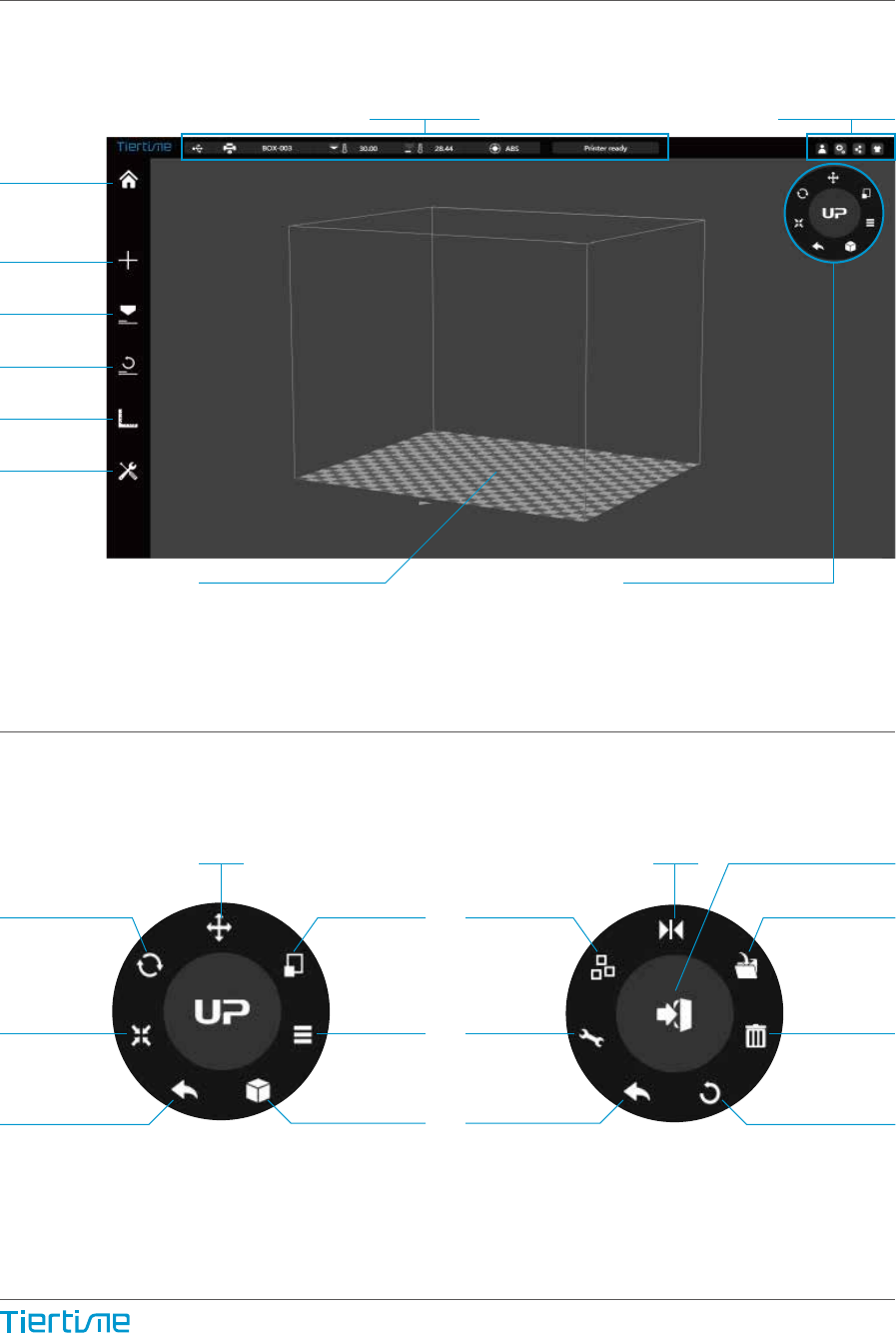
Software Interface
Printer Status Other Options
Home
Load File
Print
Initialize
Calibrate
Maintenance
Model Adjustment WheelBuild Platform
Rotate
Undo
Move
Scale
View Angles
To Menu 2
Mirror
Merge
Fix
Save
Delete
Undo Reset
Back to Menu 1
Menu 1 Menu 2
Auto Place
10
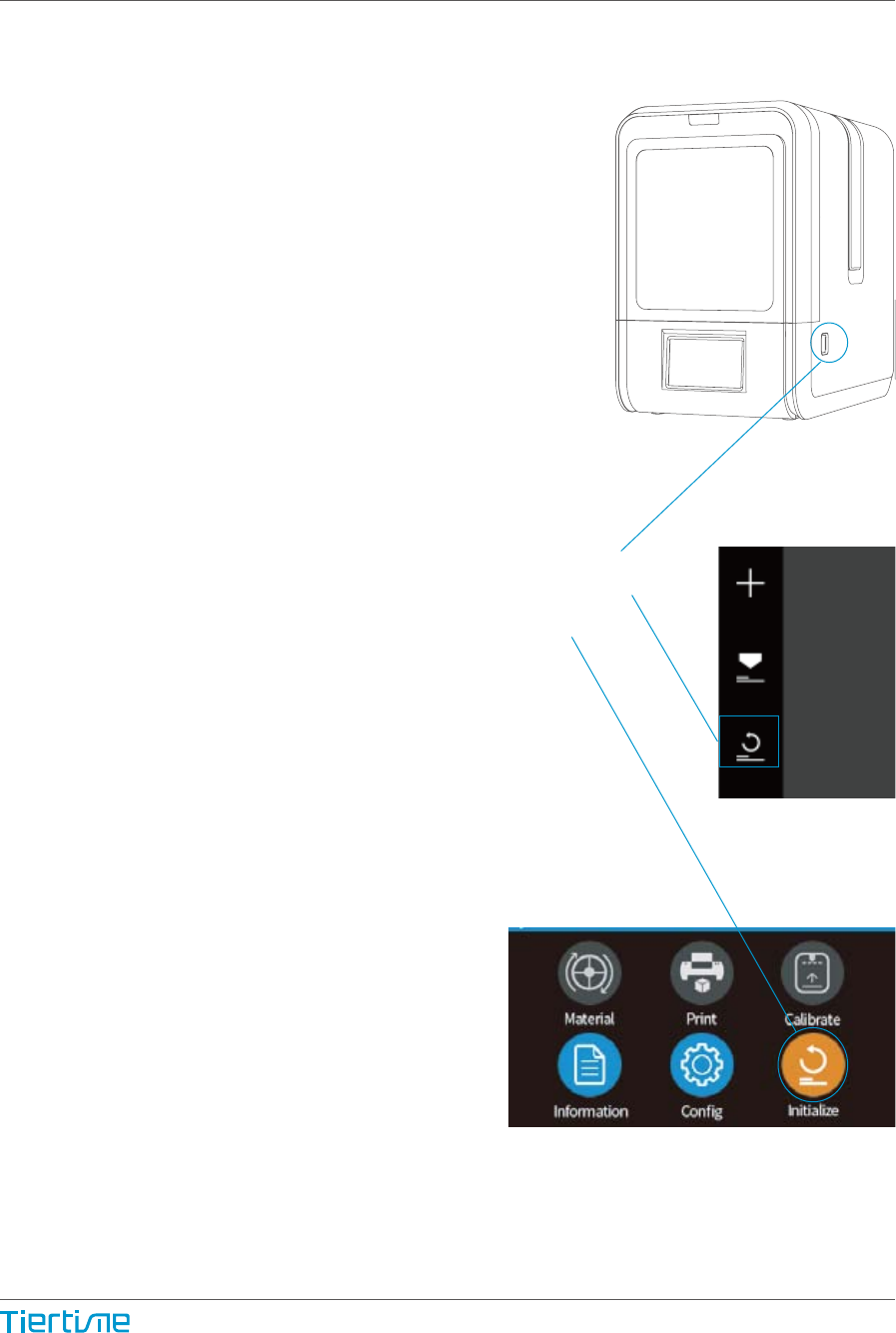
Initialization of Printer
Initialization is required for every time the
machine is switched on. During initiali- zation,
the print head and print platform move slowly
and hit the endstops of the XYZ axes. This is
essential as the printer needs to nd the end-
point of each axis. Many software options will
light up and become available for use only
after initiali zation.
There are three ways to initial-
ize your printer:
1. Hold the initialization button on the printer.
2. Clicking the "Initialize" option in the software
menu (shown above).
3. When the printer is idle, press the initialize
button on touch screen.
Other functions of Initialization
Button:
Stop the current print job:
1. During a print, press and hold the button.
2. Reprint the last job: Double click the button.
3. Turn on/off internal lighting: Single click the
button.
Initialization
Button
Initialization
button
PC client
Tocuh Screen
11
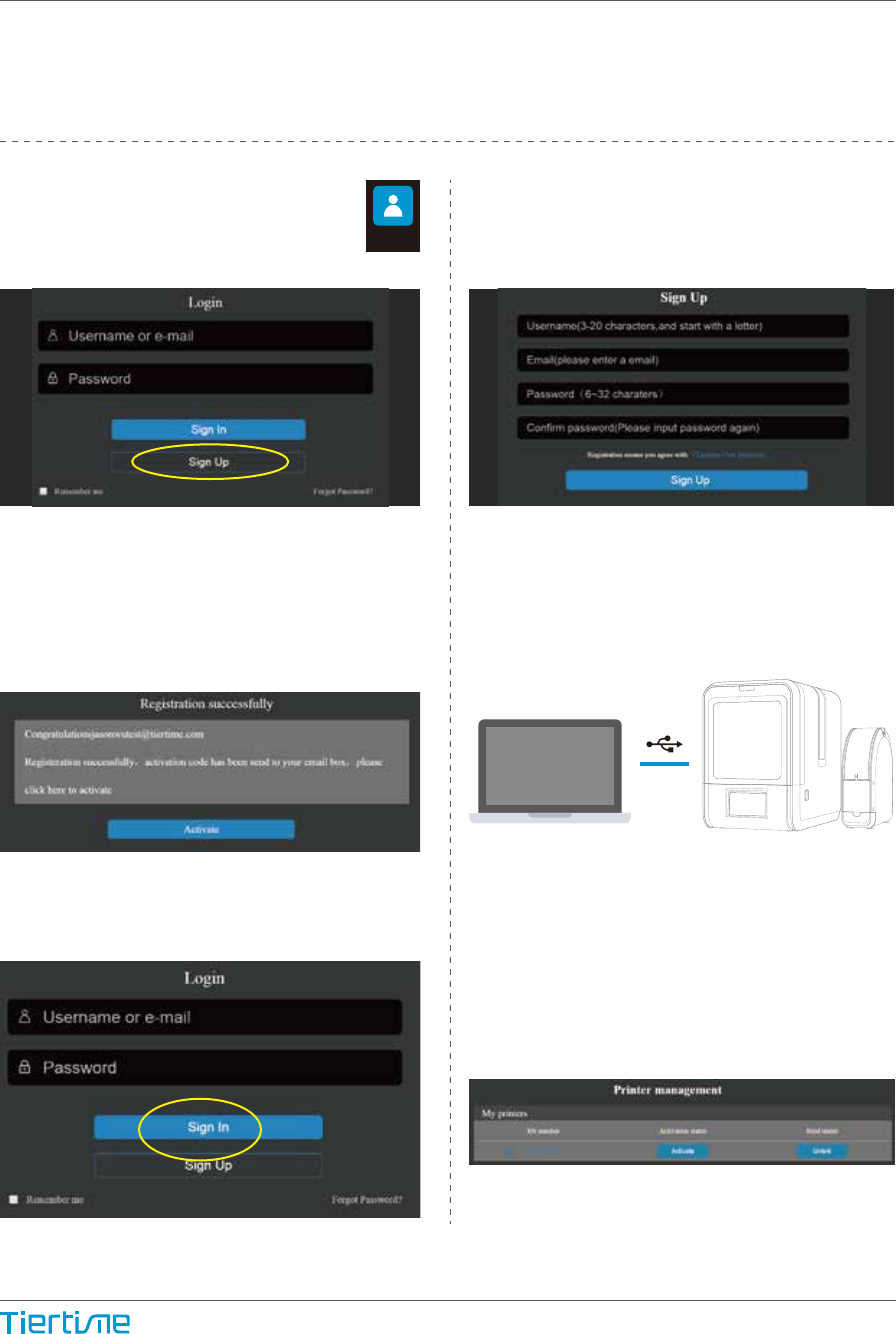
1\ Click the“Account”button at
the main menu to Sign Up.
3\ Go to your registered mail box, and
activate your account through the
activation email.
5\ Go to Account section and sign in.
7\ Restart the printer after the activation.
6\ You will see a list of connected
printers. Click“Activate”to finish the
activation. User could also choose bind
or unbind option in the user account
under the“Bind Status”.
2\ If already registered, skip to step 5.
Fill in the form.
4\ Connect UP mini 2 ES to your computer.
Account
Printer Activation
Activation will lift the restriction of the number of prints, and provide val-
ue-added services for the users.
12
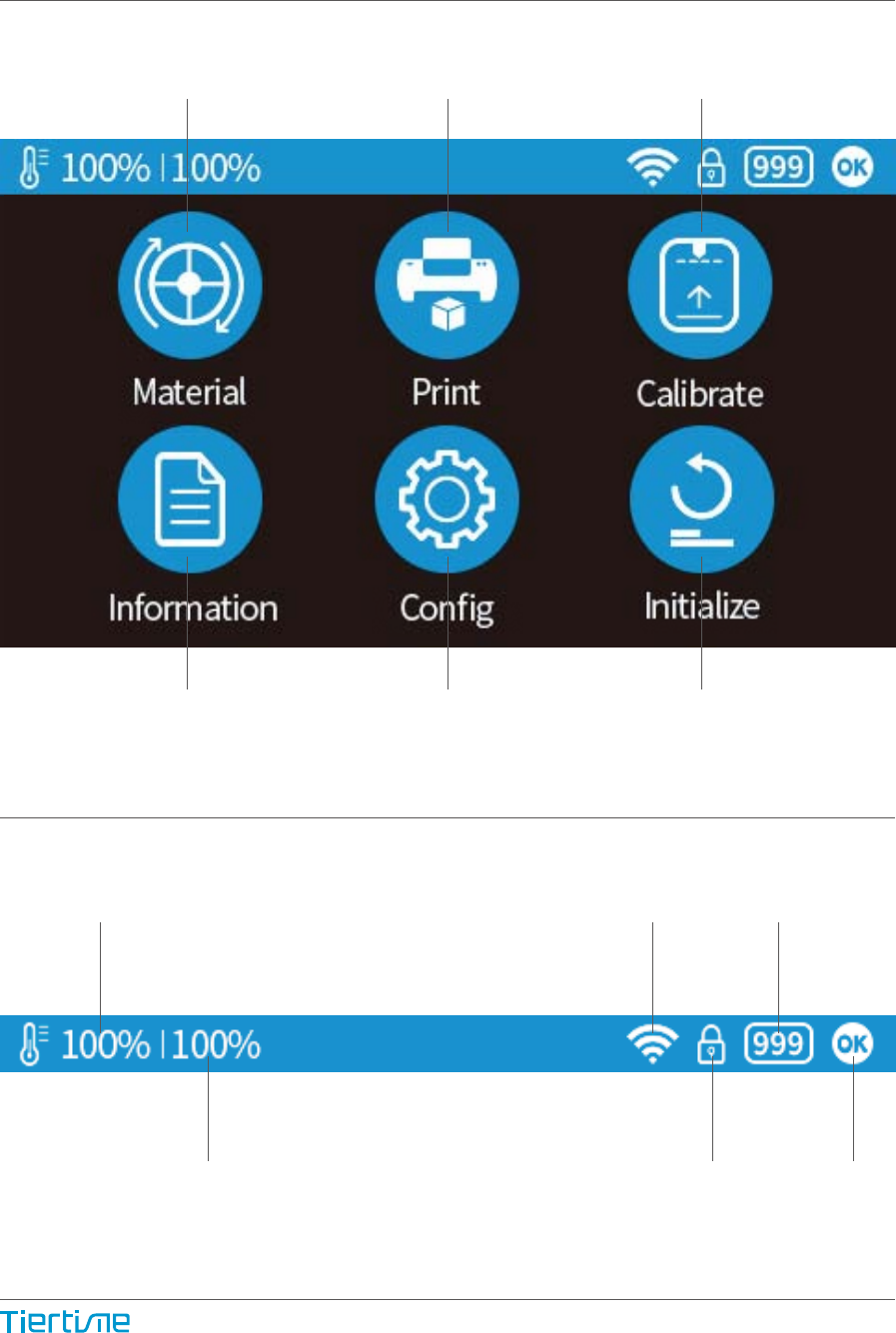
Change printing
Material Print a stored project Machine settings
including Wi-Fi
Printer Info, reset to
factory and choose
language
Nozzle Height Detection Initialize the printer
Nozzle Temperature
Platform Tem-perature
WIFI Status
Private set-
ting status
Remaining
material
Printer read-
iness status
Touch Screen Control
13
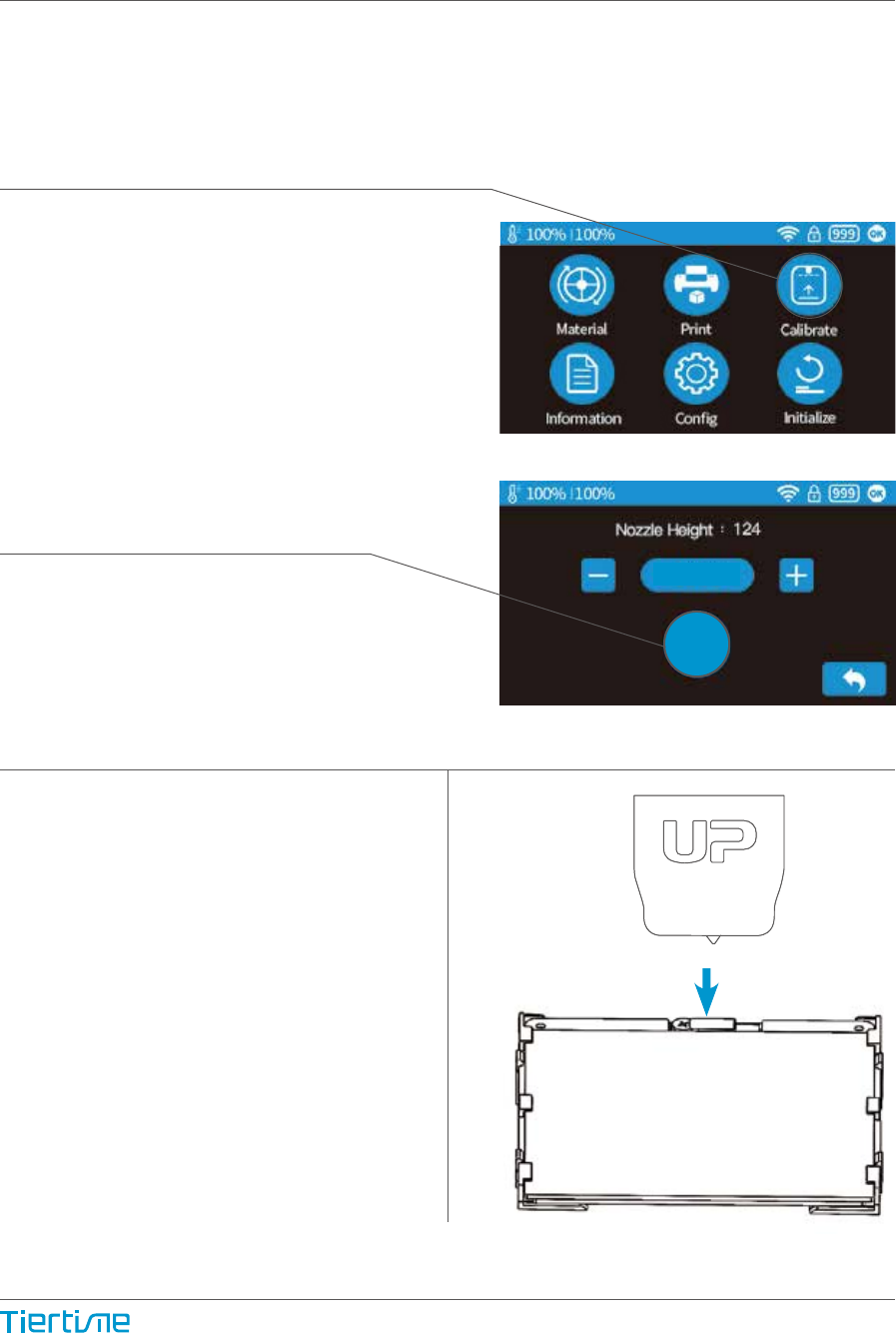
Prepare for Printing - Update Nozzle Height
The printer was calibrated before leaving the factory, but users are recommend to
update the nozzle height value using the automatic nozzle height detection function
on the touch screen before the first print.
Press “Calibrate” button to enter Nozzle
Height setup page.
Press the “Auto” button to start the
automatic process.
During nozzle height detection, the
print head nozzle will touch the nozzle
detector to make measurement.
128
Auto
14
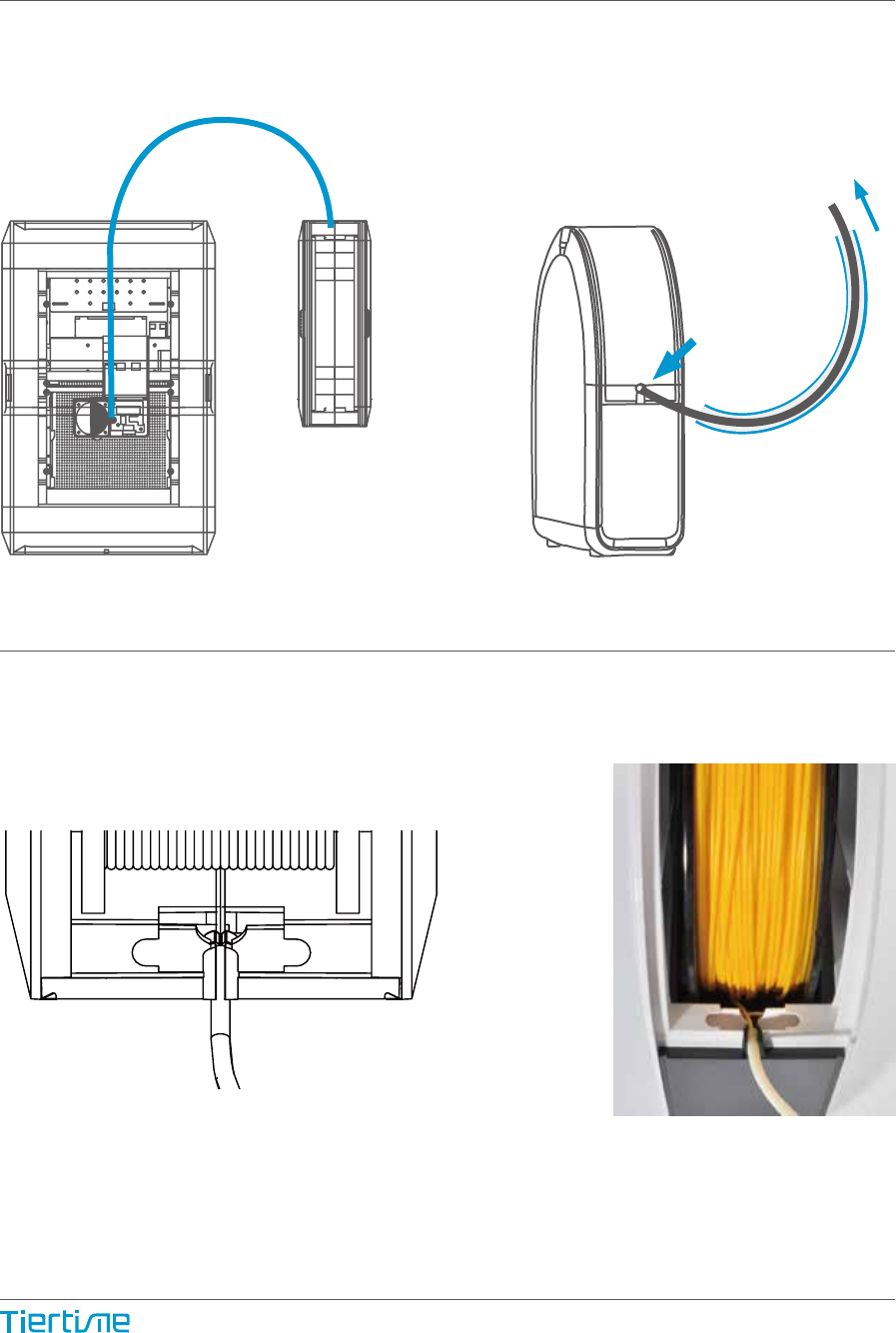
Front To printer
Prepare for Printing - Load Filament 2-1
install the lament and guiding tube shown in blue.
Push the guiding tube into the rubber ring as shown above.
15
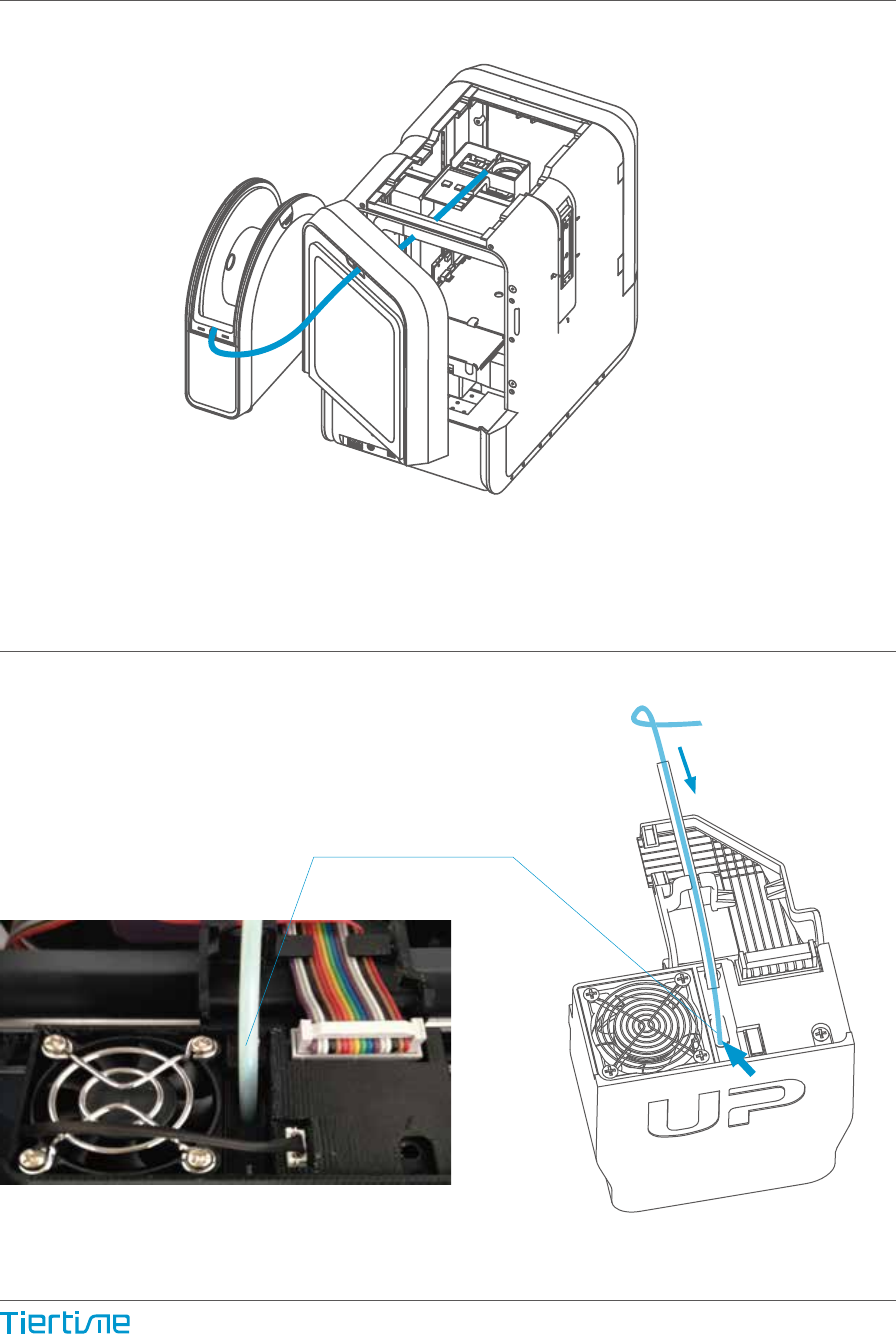
Back Side
From spool
Filament Guiding Tube
insert into the filament
entrance.
Prepare for Printing - Load Filament 2-2
16
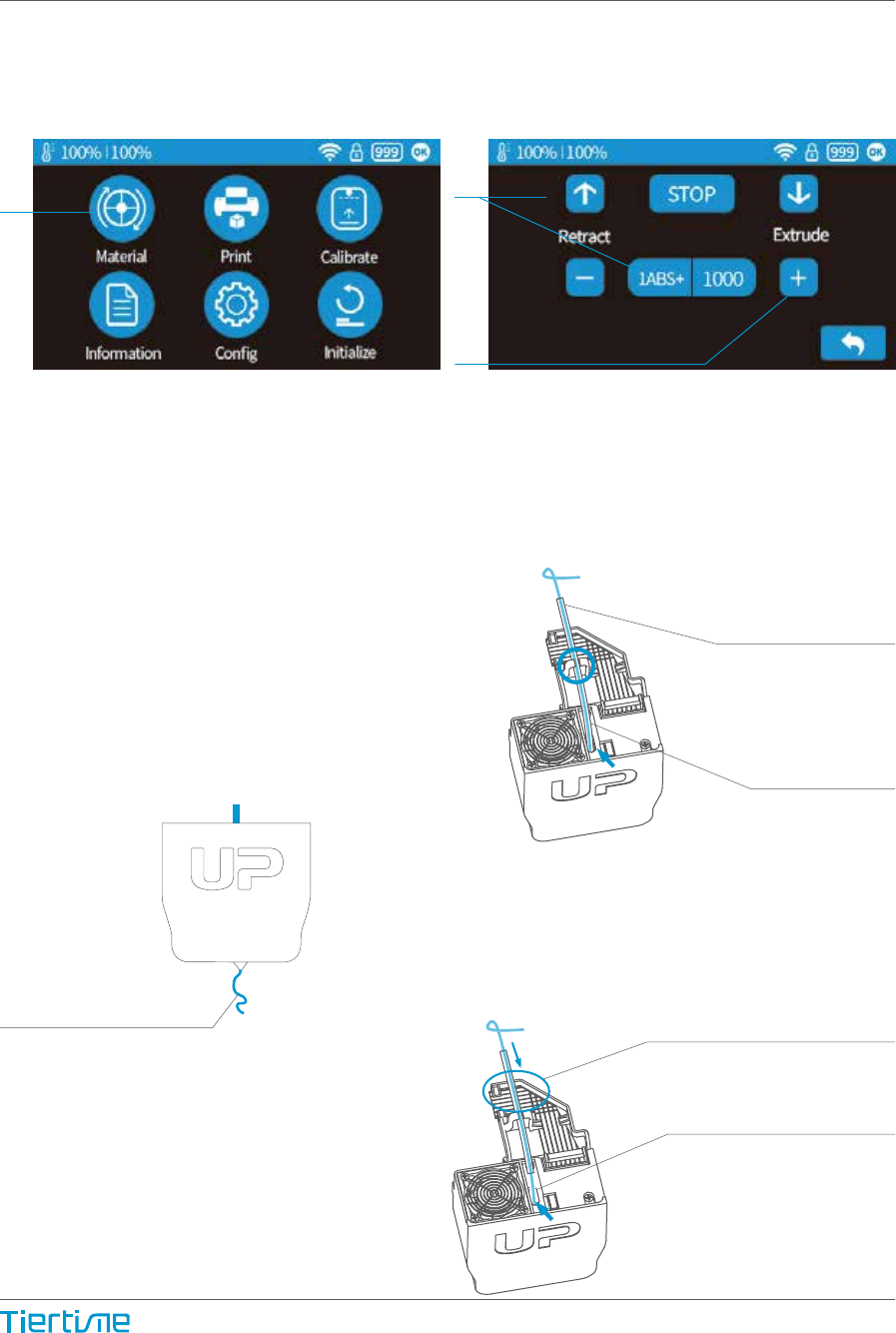
1\ Insert the filament from the spool into guiding tube, arrange the guiding tube as
shown in previous page. Press the Material button on the touch screen.
4\ Gently insert the filament into the
small hole on the print head. The filament
will be fed into the print head automatically
when it reaches the extruder gear inside
the print head.
5\ Check the nozzle for plastic extrusion.
If plastic is coming out from the nozzle, that
means the filament is loading correctly and
the printer is ready for printing. (The extru-
sion will stop automat- ically.)
6\ Finally insert the guiding the tube in
to the filament entrance and press the
tube into the holding clip on the print
head mount.
2\ Choose the printing material as ABS by press the Wheel button to switch between
different materials input the filament weight by using the +/- buttons.
3\ Click "Extrude." The print head will start to heat up, within 3 minutes. Its tempera-
ture will reach 260°C, then the printer will buzz and the print head will start to extrude.
Guiding Tube
Filament
Guiding Tube
Press the guiding tube
into the clamp
1\ 2\
3\
Prepare for Printing - Load Filament
Filament extrusion
17
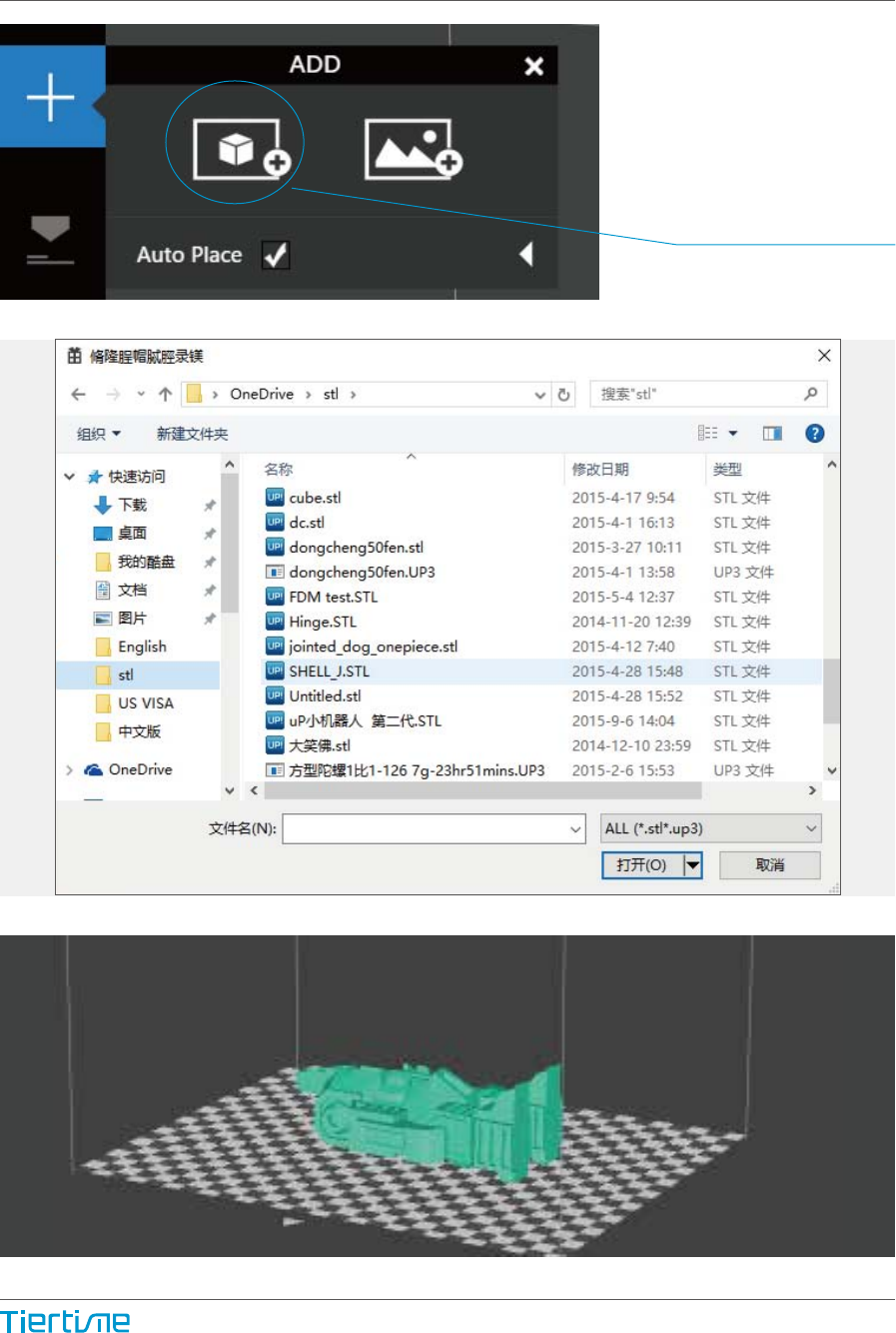
Loading a 3D Model
Load Model Button
18
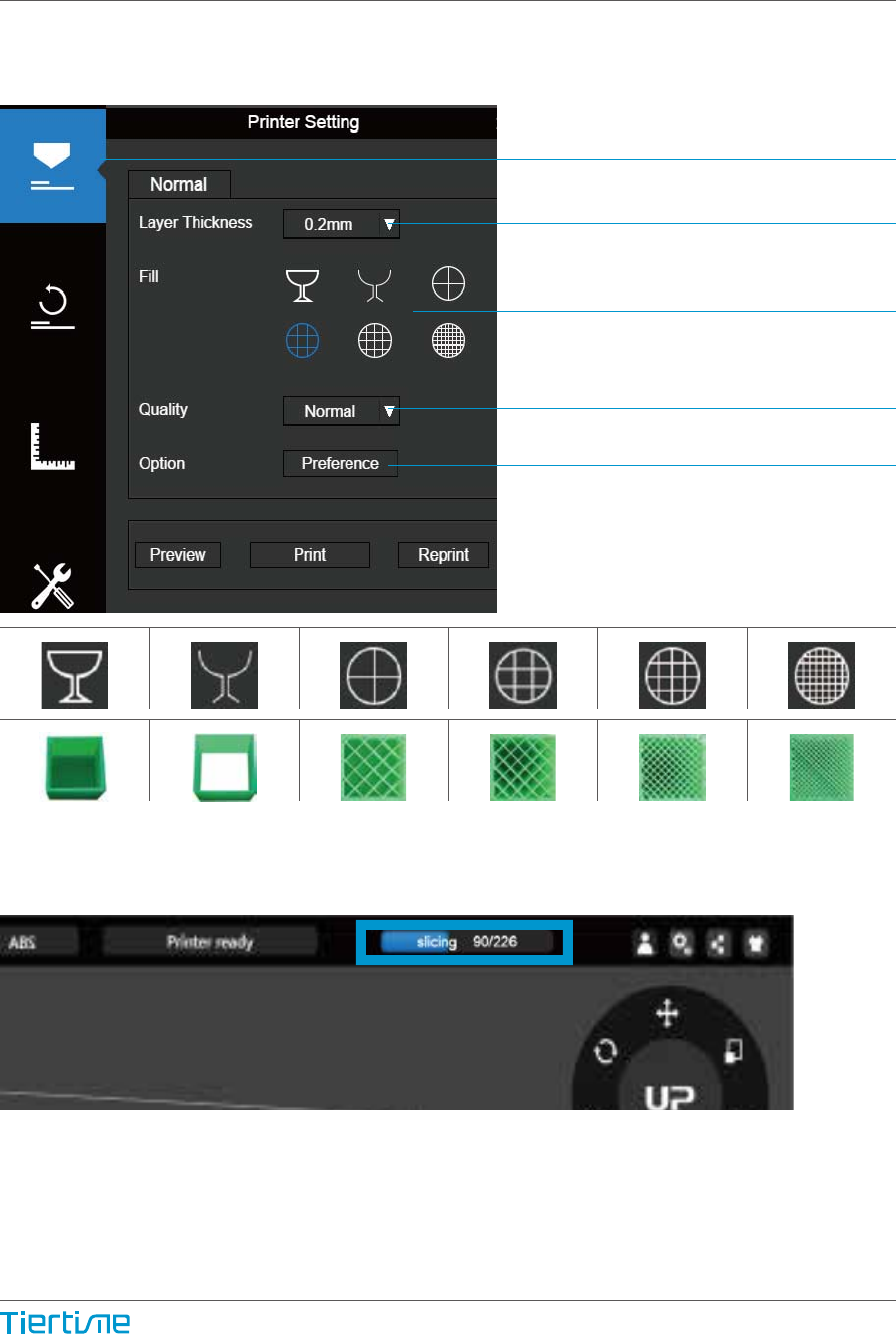
Click print button to open
the print interface
Set Layer Thickness
Select Infill Type
Select Print Quality/Speed
Advanced Options
Shell: No infill,
normal wall. Surface: No
top and bottom
layers, no infill,
single perimeter.
Hollow Big Hole Loose Fill Solid Fill
Print a Model
Make sure printer is connected to computer throug USB or WIFI ( go to page 25 for
details about WIFI setting)and loaded a model.
When the UP software is slicing or sending data to the printer progress dis- played on
the status bar on top of the software interface do not unplug the USB cable as this will
disrupt the data transfer and result in a print failure. The USB cable can be unplugged
after the data transfer is finished.
19
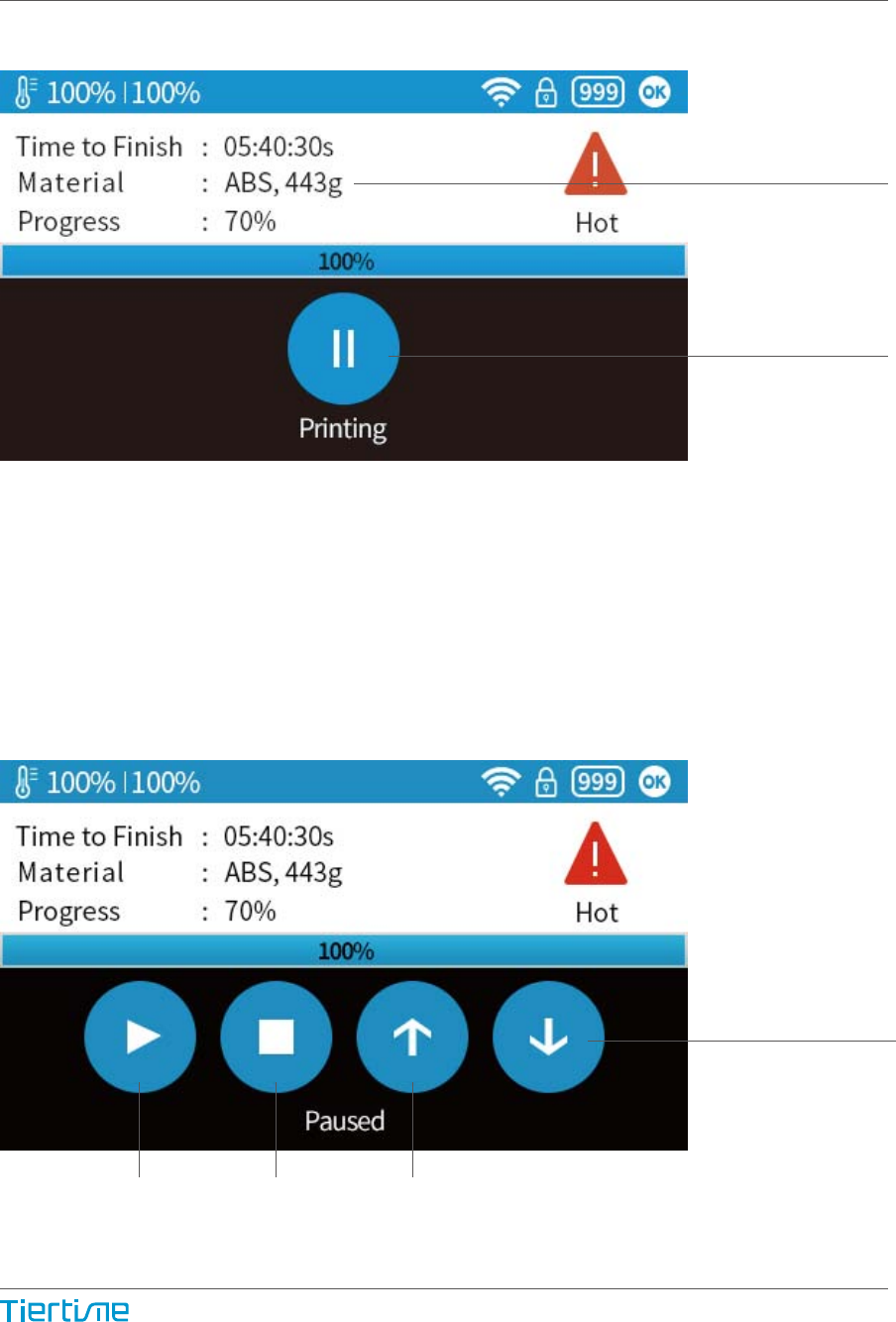
Print job progress
Pause print job
Resume Stop Print Job Retract
Extrude
Printing Progress
After pressing the pause button, the nozzle will be paused but temperature is main-
tained at printing temper- ature. During pausing, the following control buttons will
appear to allow users to resume, stop or change filament.
Please note the stopping is irreversible, the current print job can only be restarted
from begining.
20
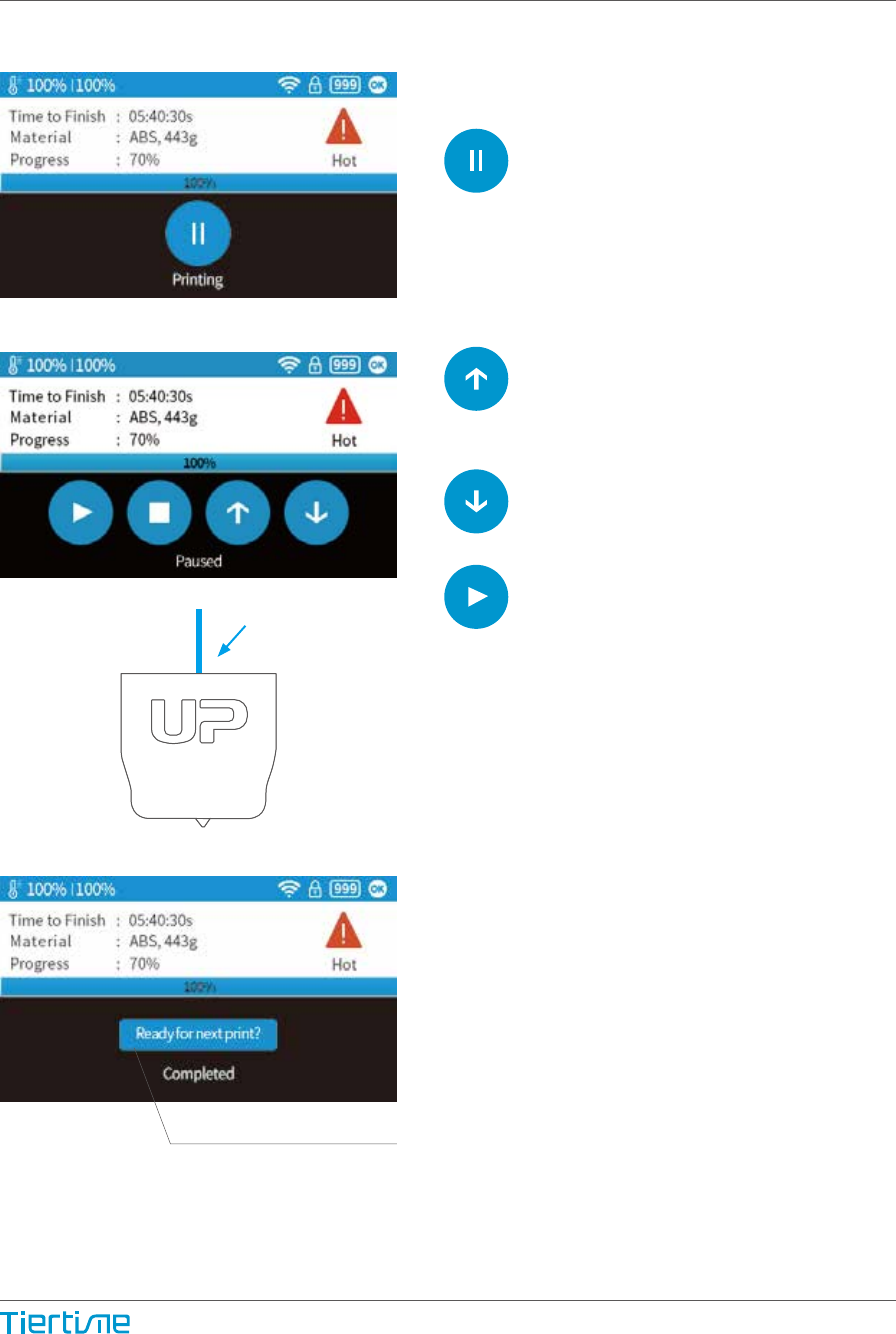
1\ During printing process the
“Pause” button, the printing job
will be paused.
2\ When print head stopped
moving and platfrom lowered.
Press the “Retract” button to
remove filament.
After filament was removed, insert new
filament to the print head as described in
page 16.
Printer ready confirmation:
After the print job was finished, the user
need to press the “Ready for next print?”
button to confirm the printer is ready. User
should make sure the previous print job is
removed from the platform before pressing
the button. The printer cannot start a new
print job if they did not confirm the status.
Press the “Extrude button” to load
the new filament
Press the “resume” button to
resume printing.
Confirmation button
Change Filament During Printing
Print Job Finished
21
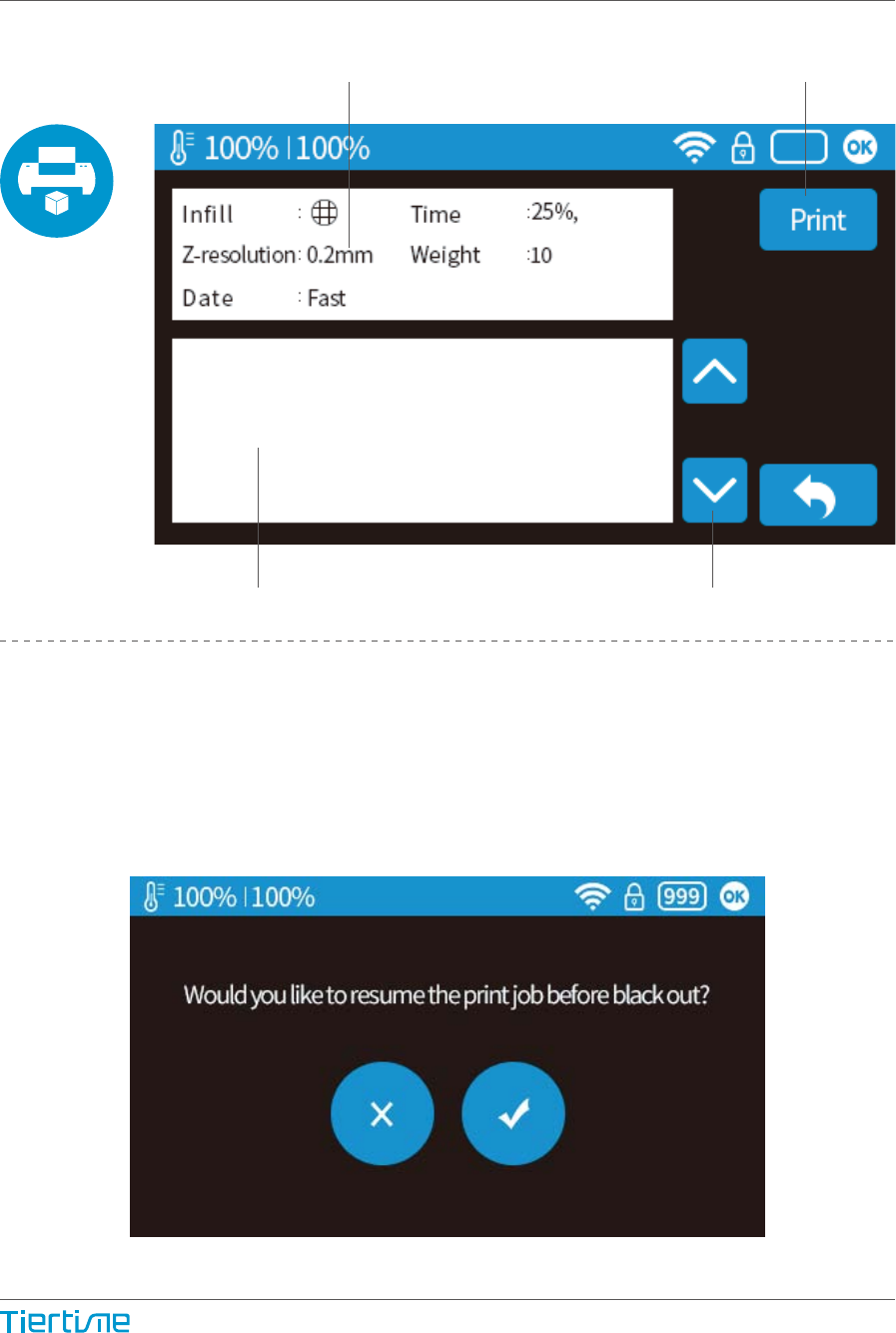
Info of the stored file print job
Stored file name Change Page
Start Printing
Test001
Test002
Reprint or Printing Stored Print Jobs
Black Out Recovery
If electricity was cut off during printing, the print job can be contuinued after resuming
power supply. Do not remove the print job from the platform after the black out. When
the machine was turn on again, initialize the printer. The printer will ask whether user
would like to recover interrupted print job.
22
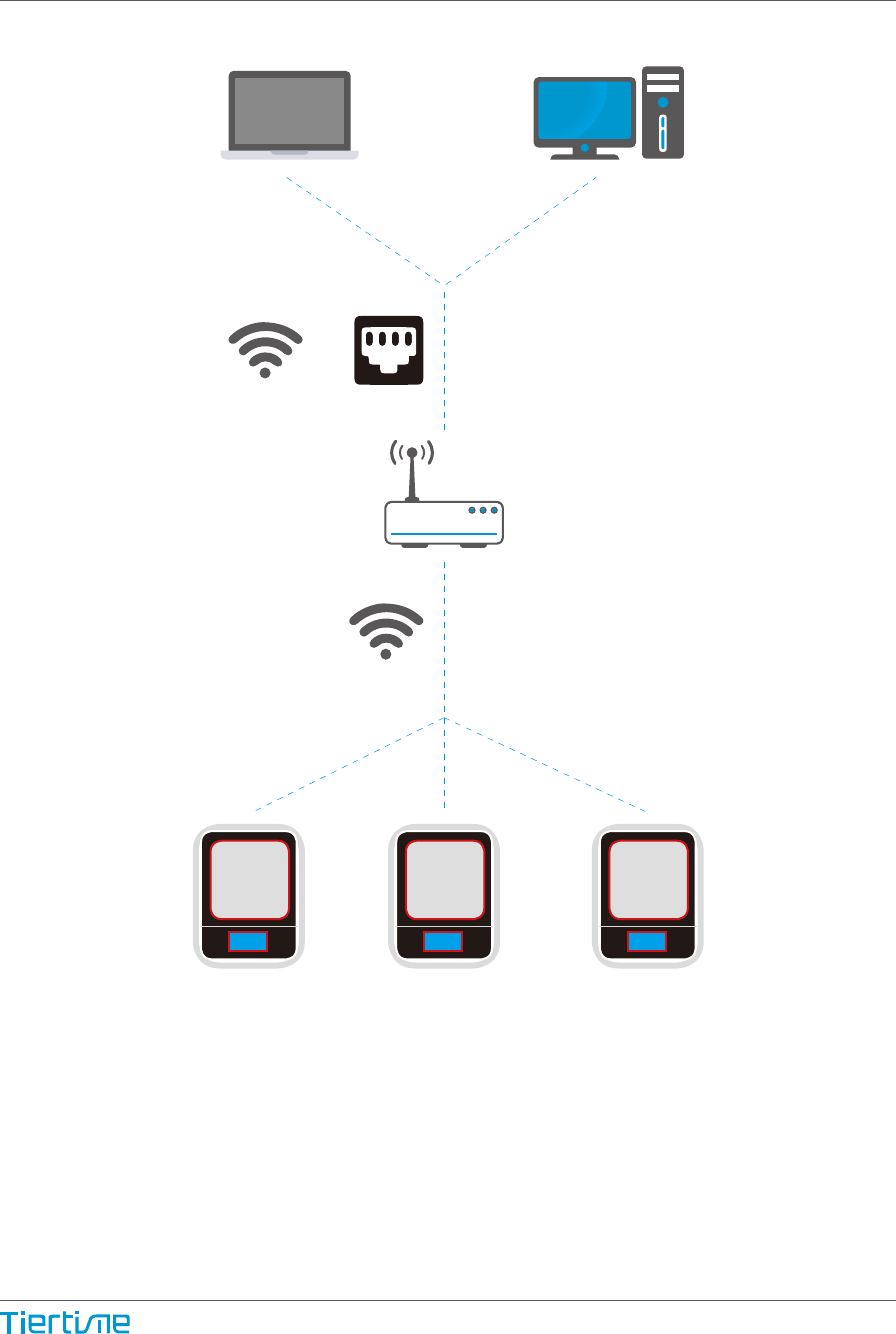
Machine Settings - WIFI Connection
or
Connecting to the UP mini 2 ES through WIFI requires a Wireless Local Area Network
(WLAN). Computer and printers must connect to the same WIFI network (same SSID)
before able to communicate.
In order to acheive stable WIFI connection, users are recommended to connect under
a capacious WIFI environment. A crowded network or an area with a large number
different networks are known to cause interruption during data trasnfer.
23
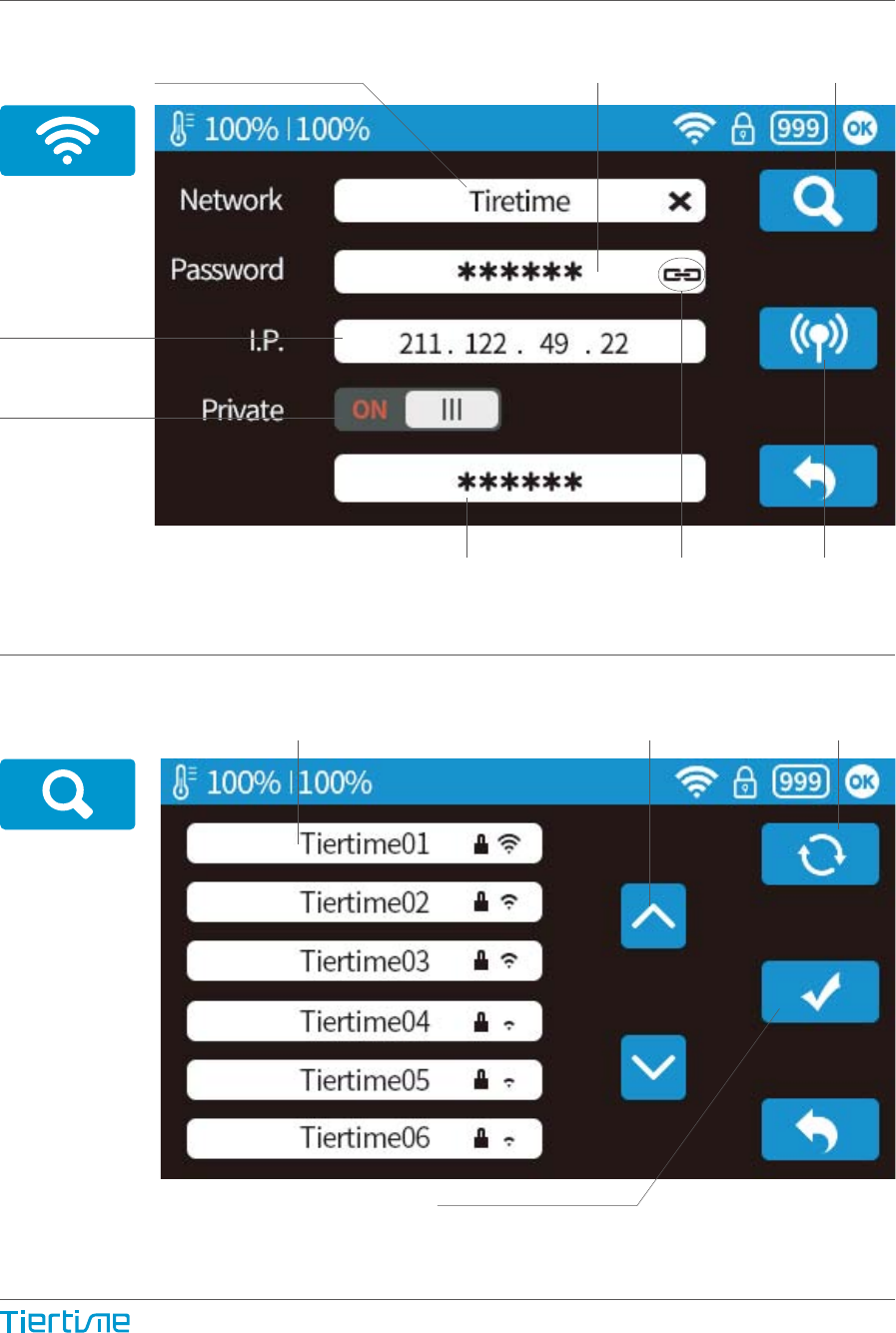
IP address
Private setting,
which add pass-
word for WIFI
connection.
SSID Input Input WIFI Password
Input Private Pass- word
Select WIFI
WIFI connected Connect to
current WIFI
WIFI Setup through Touch Screen.
Detectabe WIFI Network
Select WIFI
Flip Page Refresh
24
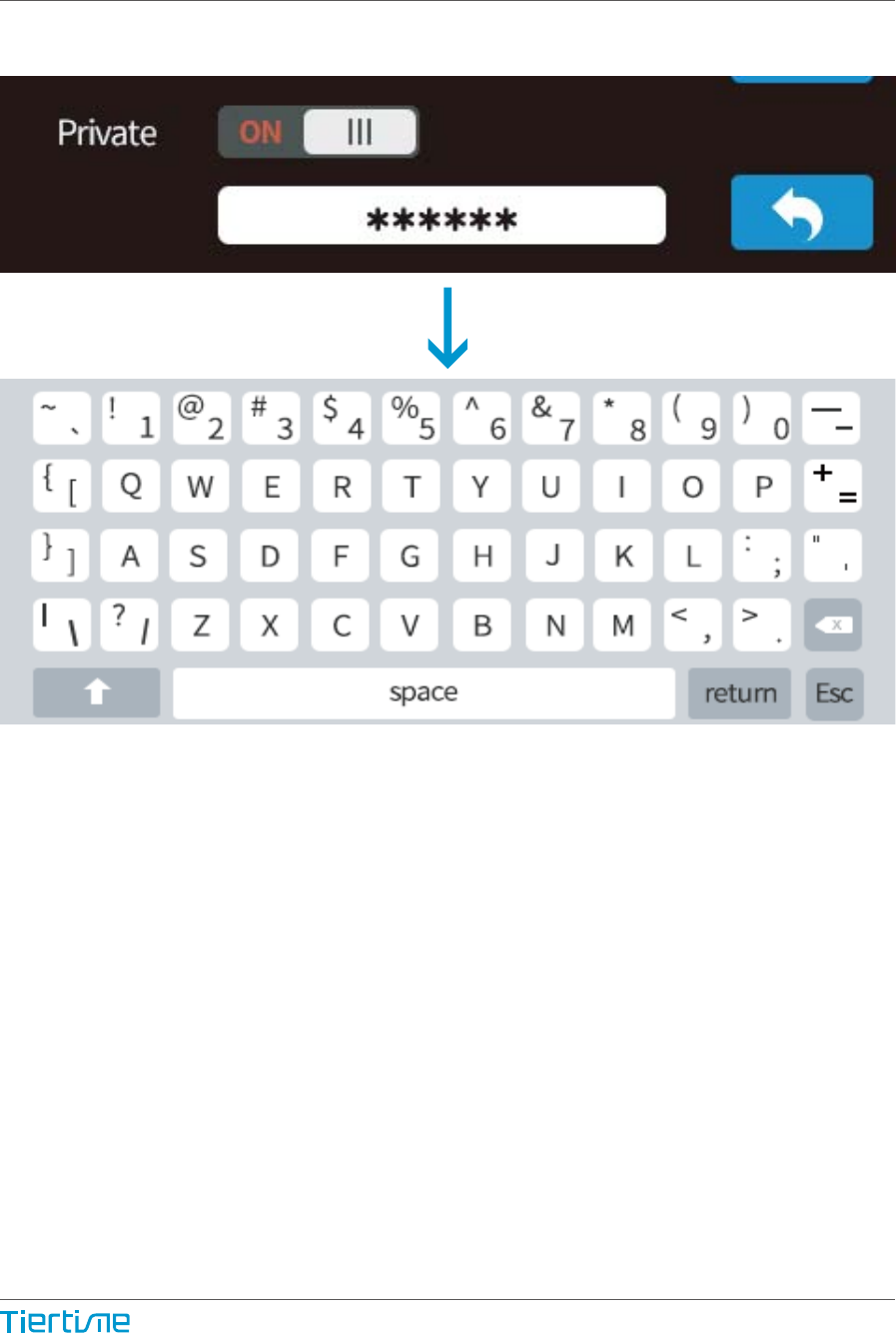
Setup Private WIFI Access
If user switch on the private function in WIFI setting, a password field will
appear to allow passowrd setup. This is password that will be required for
WIFI connection to the printer to prevent unathorized usage through
WIFI. Please note this is a weak protection that anyone who can access
to the printer through USB or touch screen could changet the private
password.
25
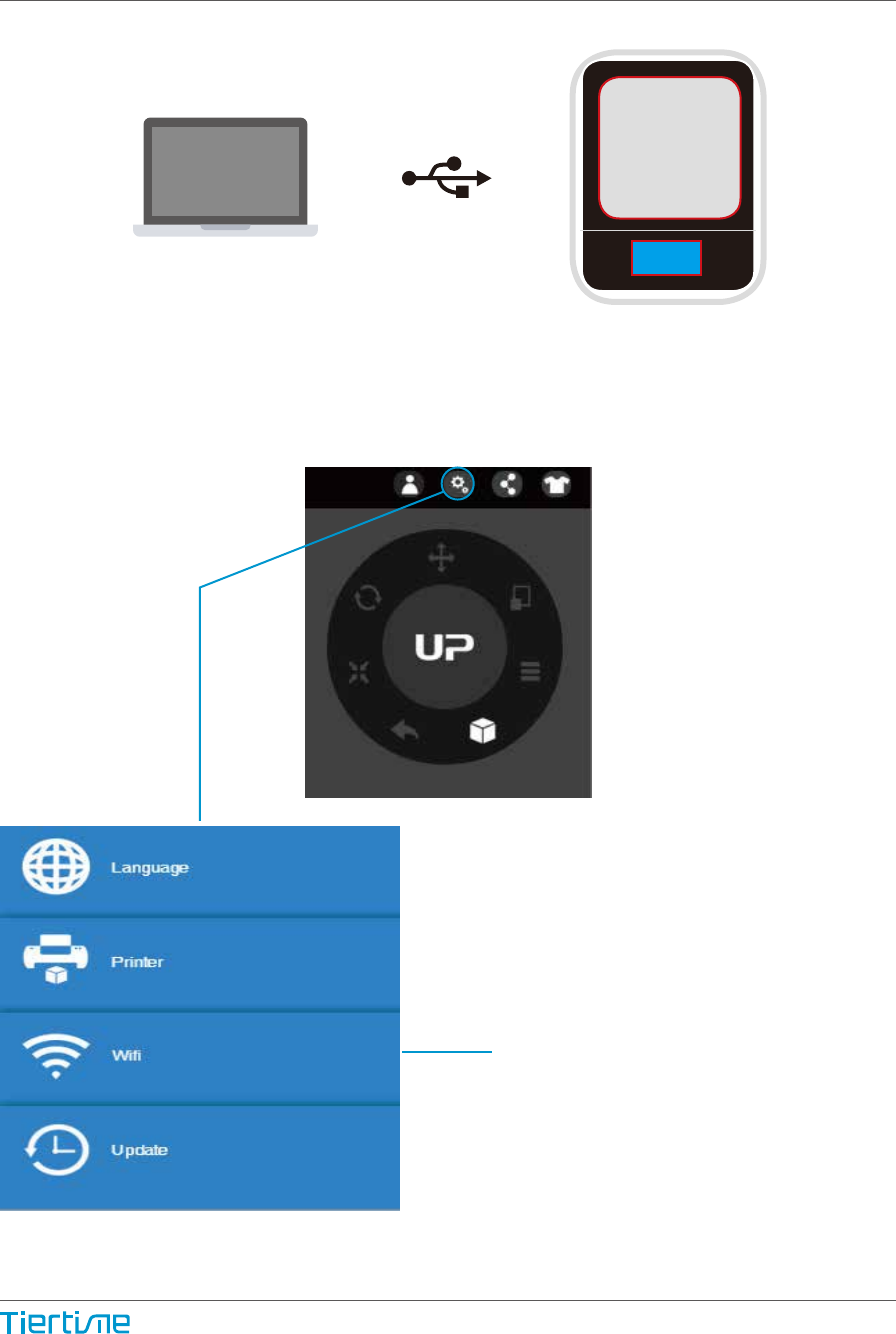
WIFI Setup (UP Studio)
1\ Connect UP mini 2 ES to computer through USB.
2\ At top right corner click the setting
button and then click WIFI tab.
3-1
26
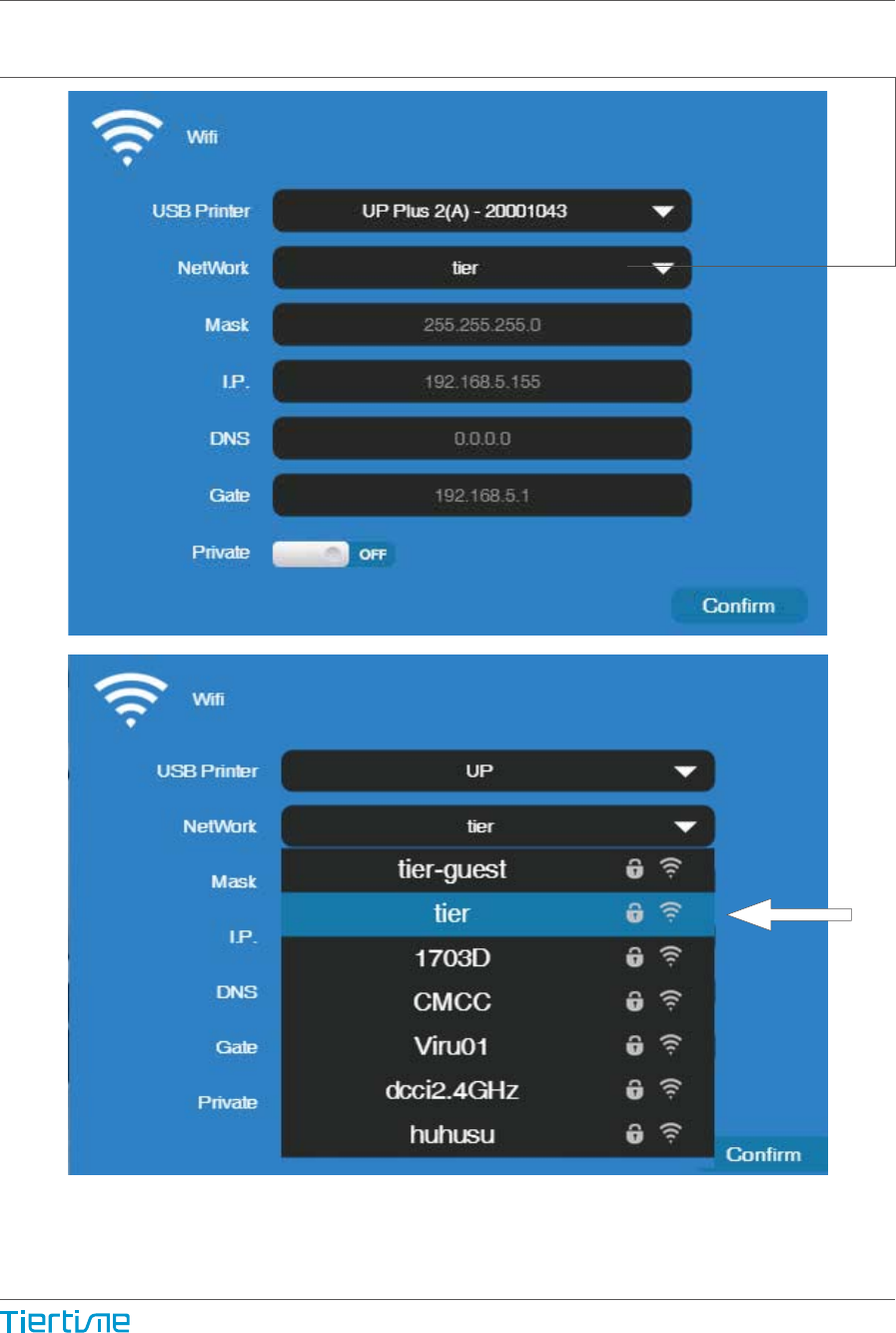
3\ Click network to choose an available network ( user can also use touch screen
panel to setup WIFI connection).
Choose your network from the drop down list.
WIFI Setup (UP Studio) 3-2
27
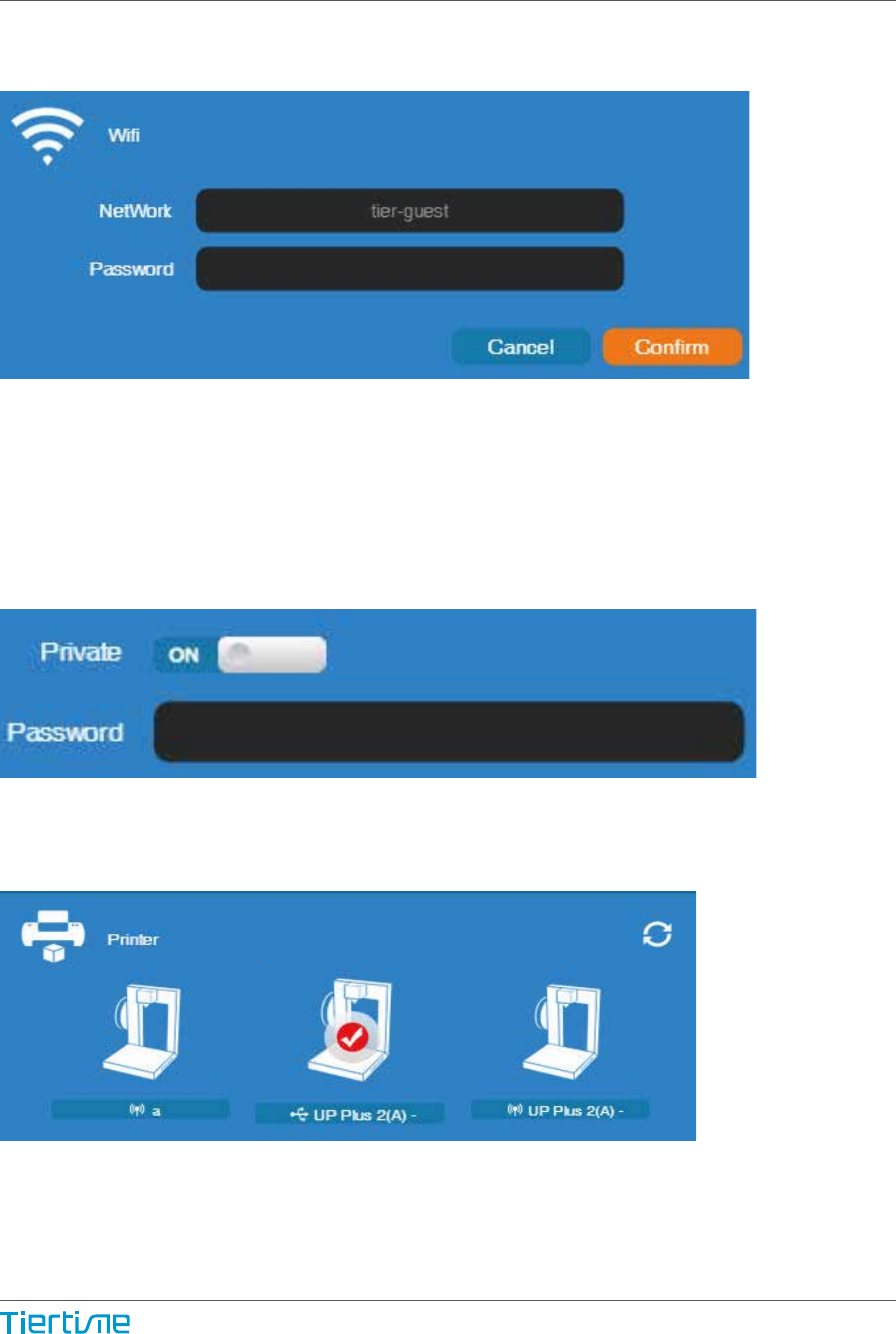
5\ If “Private” is set to ON, a private password could be optionally added to limit
printer WIFI access to trusted users. Please note that the password is a weak protec-
tion that can be accessed and changed by anyone who can connect the machine
through USB.
4\ Input the password for the WIFI network.
6\ Printer Tab
Disconnect USB and choose available printers on the network to operate through
WIFI.
WIFI Setup (UP Studio) 3-3
28
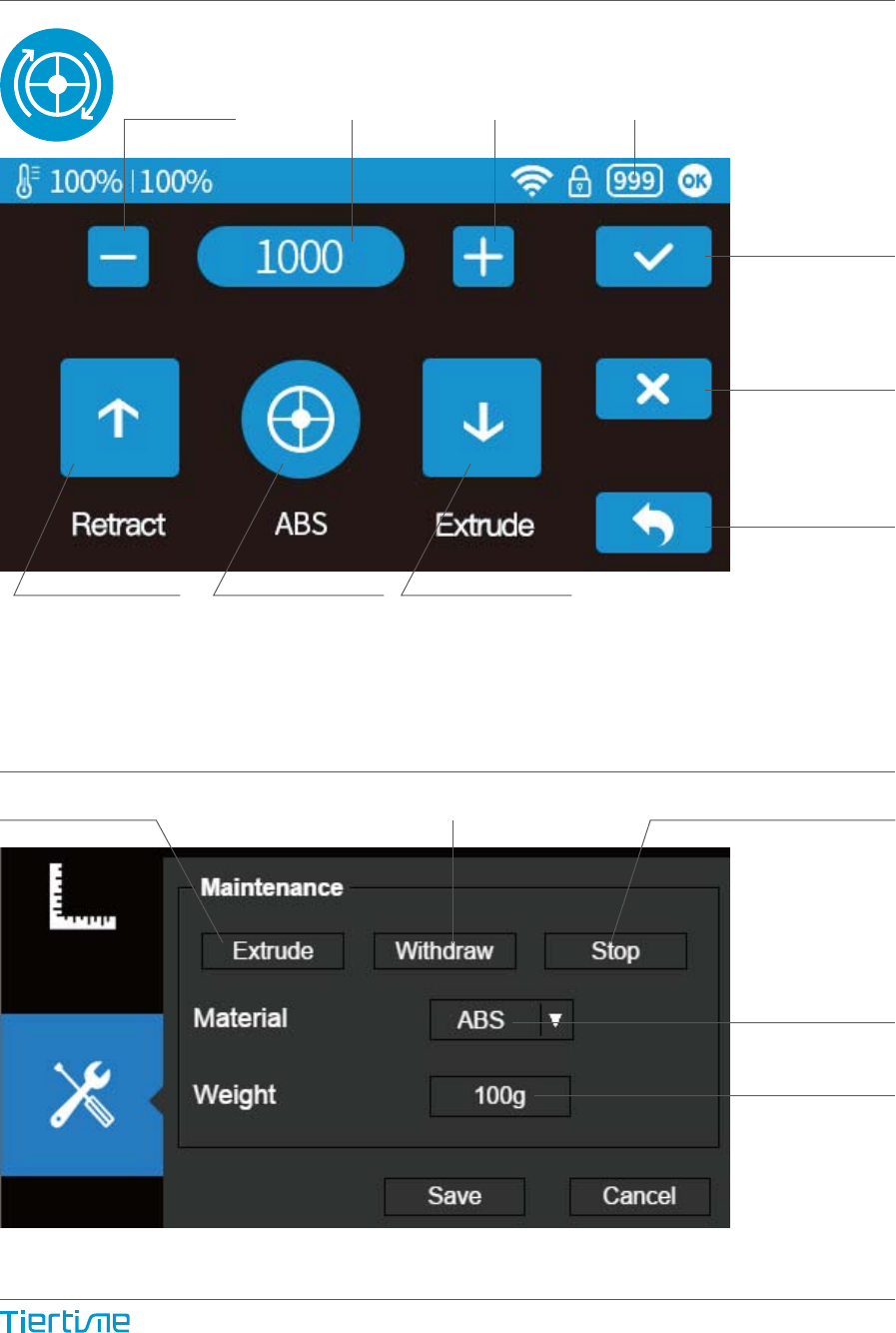
Decrease
Material Weight
adjustment current ma-
terial weight
Save current
setting
Increase
Set Materials (Touch Screen)
Set Materials (UP Studio)
Stop extru-sion
and heating
withdraw material
Extrude Filament Withdraw Filament Stop All Actions
Select Material
Input Material weight
Change Ma- terial extrude material
Back
29
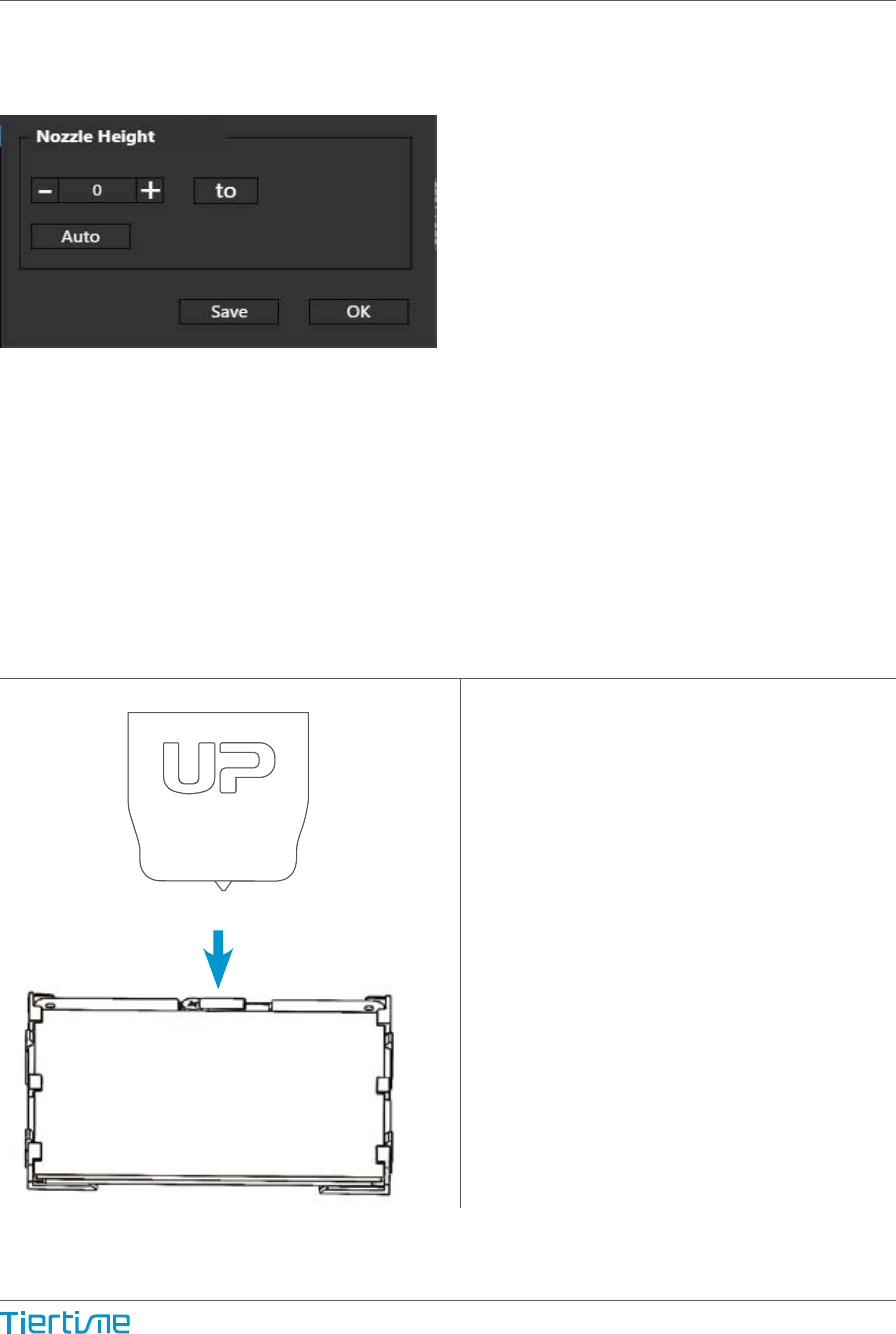
During nozzle height detec- tion, the
print head nozzle will touch the thin
metal sheet on the detector to make
measurement.
Open the Calibration panel
At the Nozzle Height section, click “Auto” will initiate the automatic nozzle height de-
tection process.
Clicking +/- button will move the platform up and down, or user could input a specific
value at the text field and click “To” button the move the platform to a specific height.
Click save will replace nozzle height value with current platform height.
Set Nozzle Height (UP Studio)
For setting nozzle height with touch screen please refer to page 16.
120.90
30
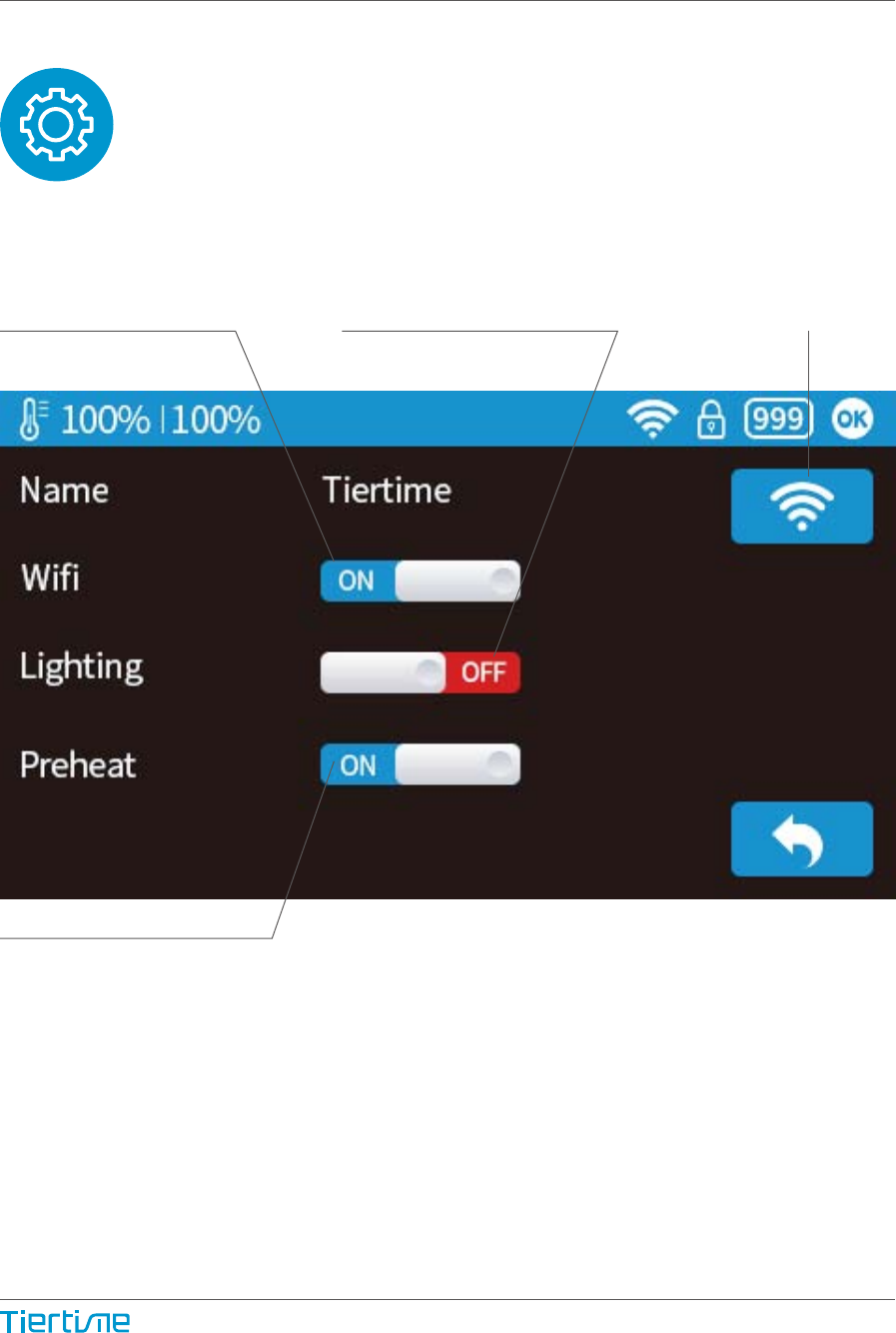
WIFI switch, if swithed off
the WIFI setting button
will not appear.
Peheat switch, when turned on,
for every print job, the printer
will first preheat 15min before
proceed to printing.
WIFI setting button
internal lighting switch
Machine Configuration
31
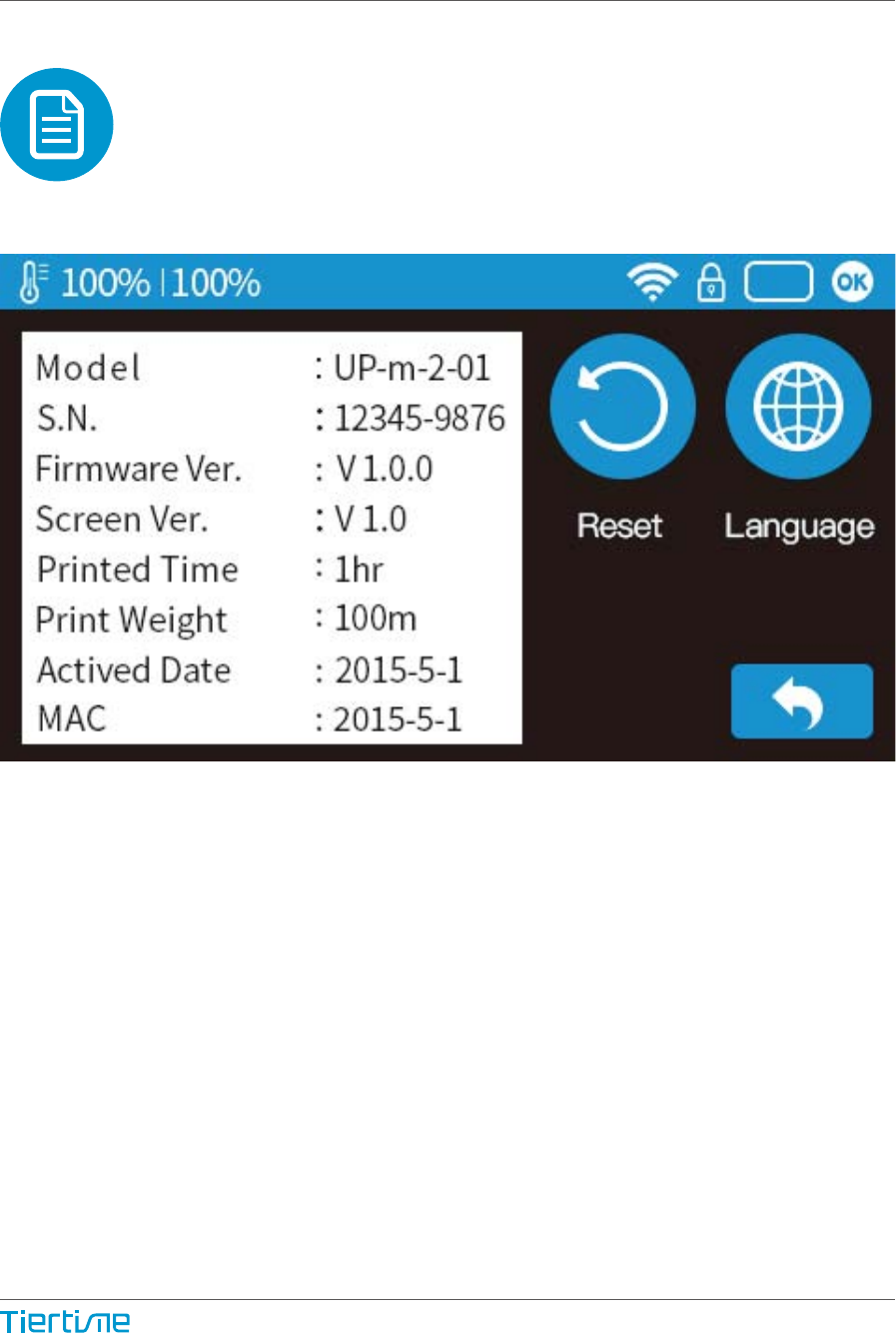
Language and Factory Reset
Model: current machine model
S.N.: machine serial number
Firmware Ver: shows current firmware version Print Time: total print time count
Print Weight: total print weight count
Actived Date: the date of printer activation MAC: mac address of printer
Reset: revert to factory setting. This will change some machine setting to default;
remove total printed time and weight data.
Language: choose language. Current available language: Chinese simplified, Chi-
nese Traditional, Korean, Japanese, French,Germany, English
32
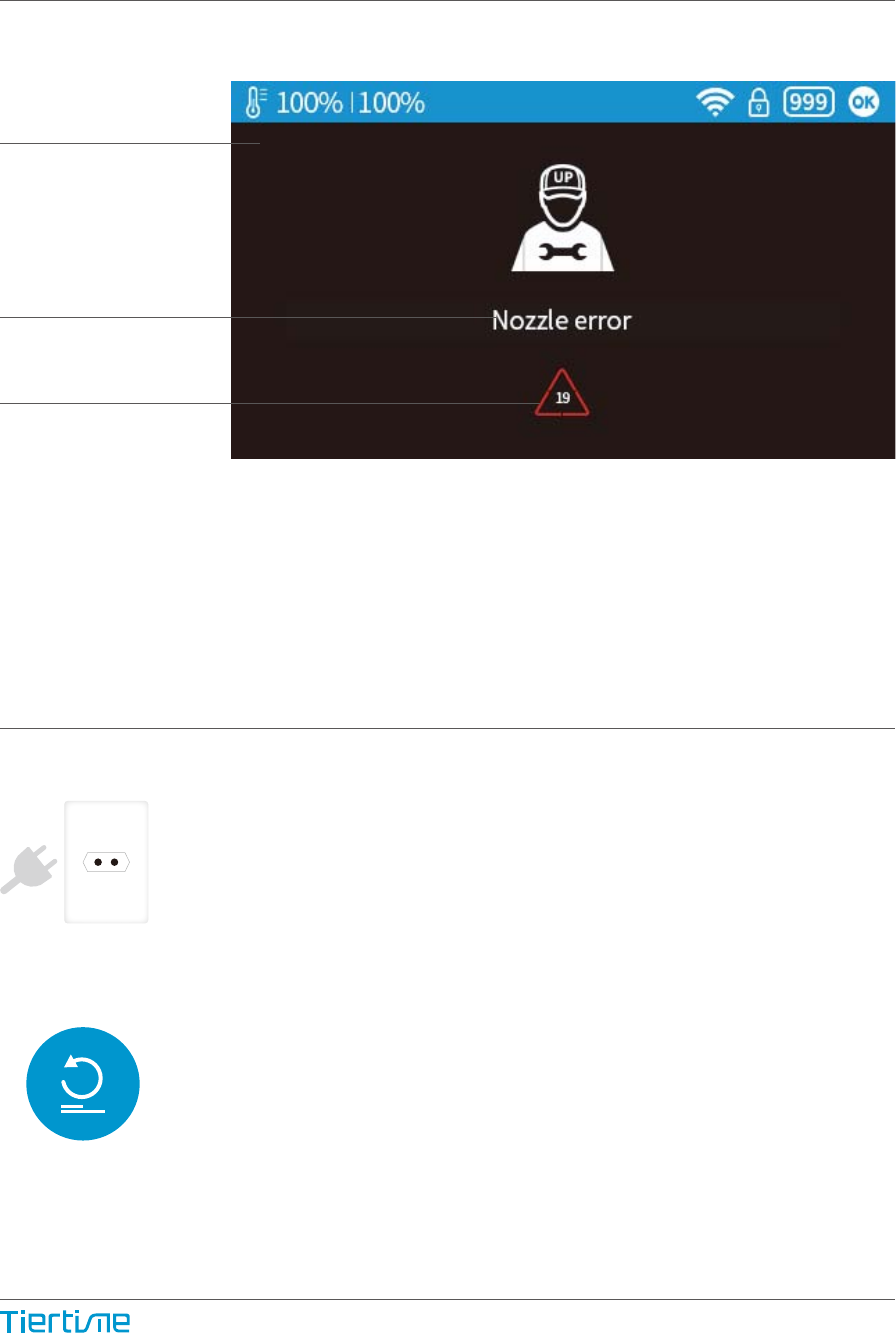
Unplug printer and restart
Suggested solution,
in this case:
Contact support
reinitialize the printer
Error Prompts
Other possible error prompt:
Error code
Error Message
33
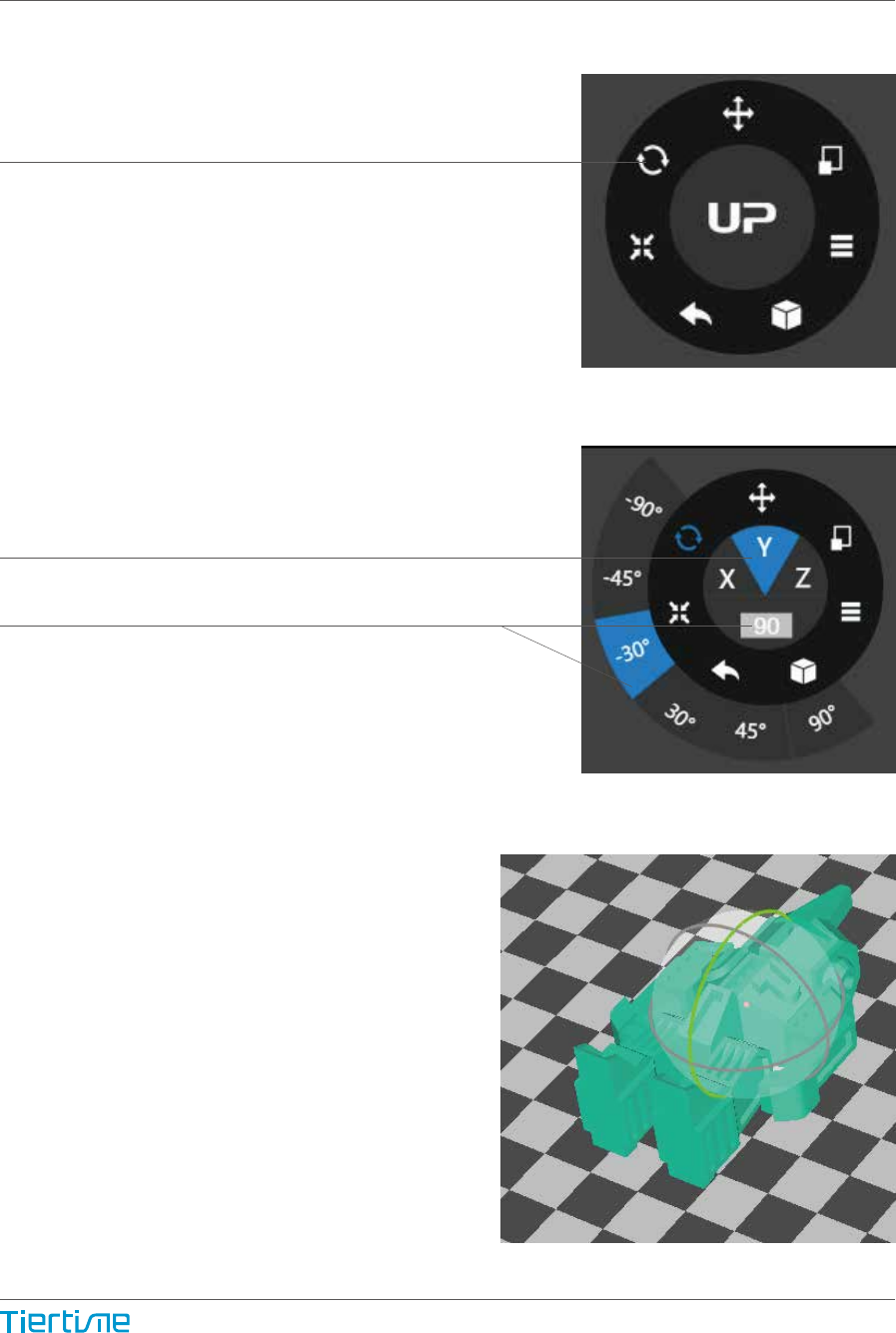
Choose the model and Click rotate button.
Choose rotation axis
User could input a specific value
or choose a preset value for rotation.
Alternatively, user could use the rotation
guide to rotate model in real time by hold
and drag with mouse.
Rotating Models (UP Studio)
34
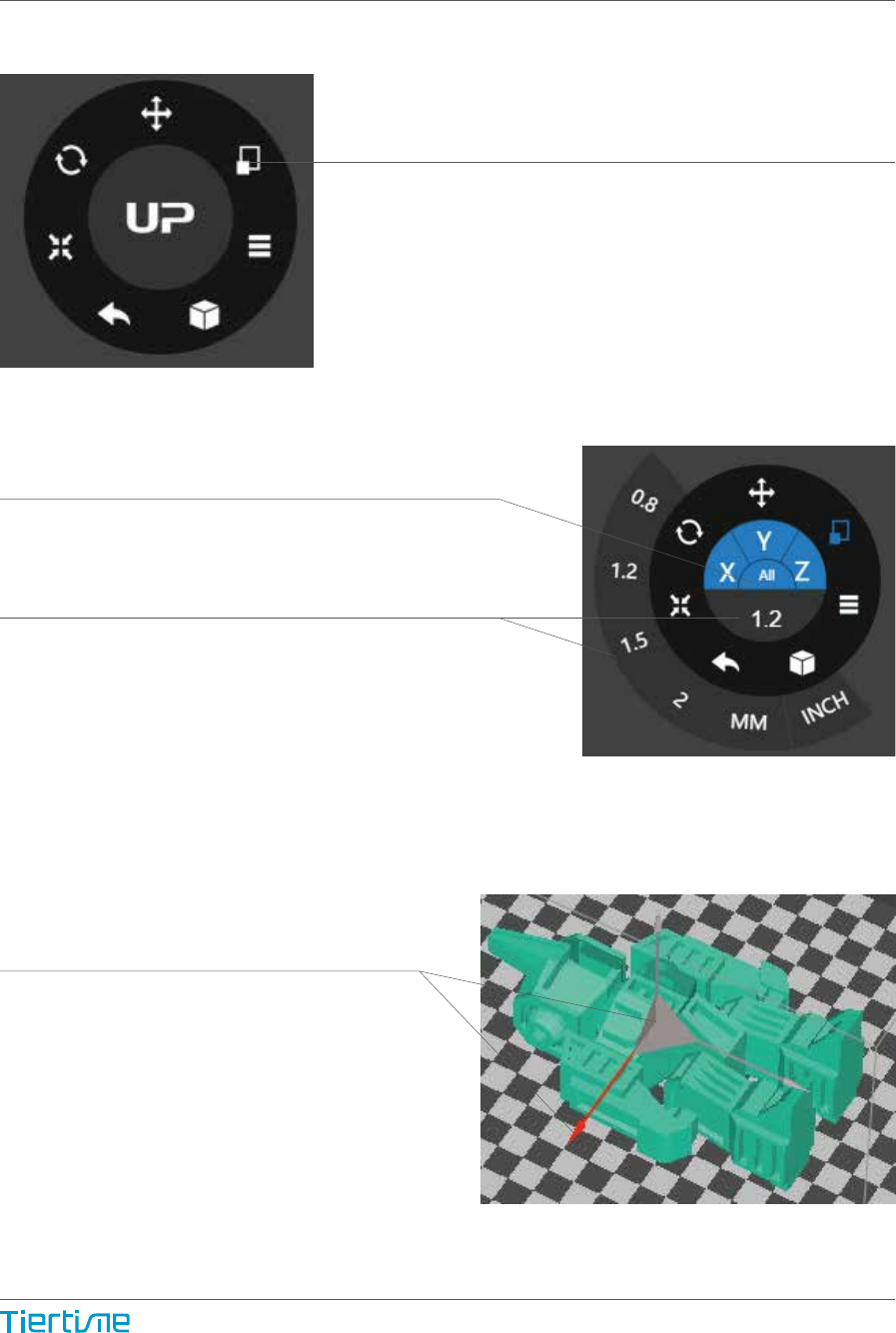
By default the scaling is in all axes.
User could also choose a specific axis for scaling.
User could input a specific scaling
factor or choose a preset value
Click MM or INCH to convert models to
sizes of corresponding units.
Alternatively, user could use the scaling guide
on the model. User could scale
in a specific axis or scale in all directions
by hold and drag with mouse.
Scaling Models (UP Studio)
Choose the model and Click rotate button.
35
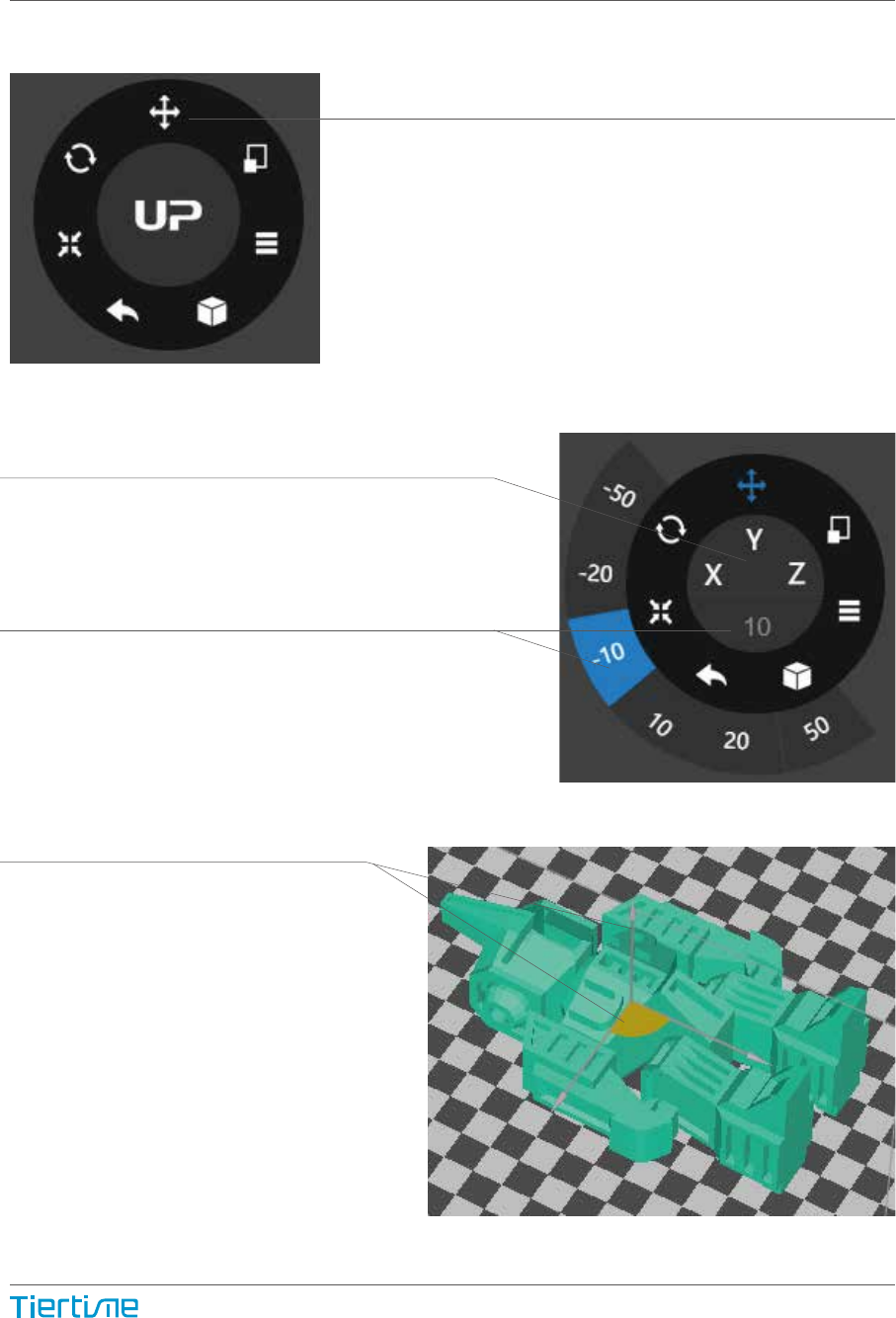
Alternatively, user could use
the translational guide on the
model to move on the X-Y
plane or a single direction by
hold and drag with mouse.
Choose the the direction of movement
User could input a specific value or
choose a preset value for distance
of movement.
Move Model (UP Studio)
Choose the model and click the Move button.
36
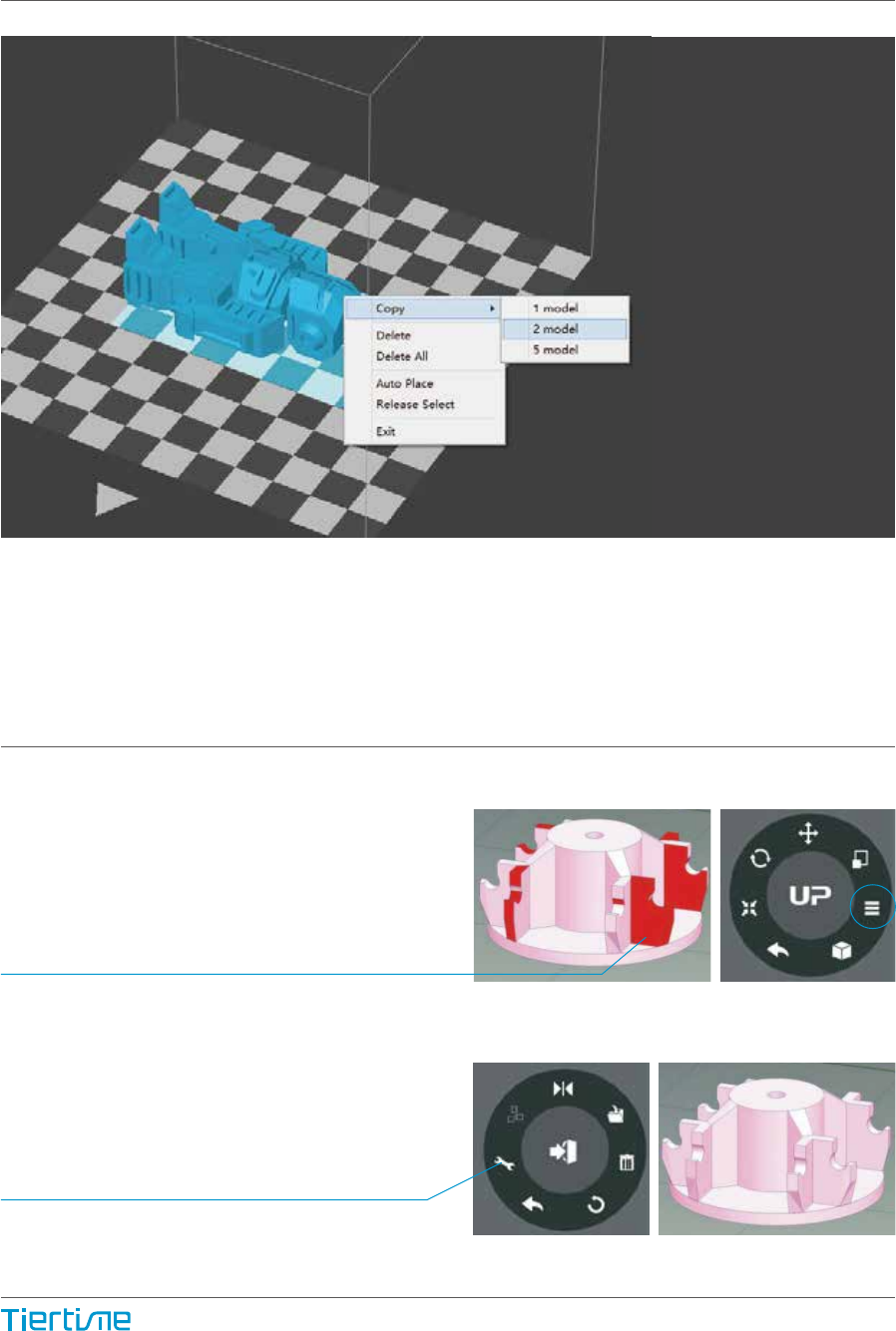
Make Copies
Repair A Model
Choose the model by clicking it (hight lighted),the right-click to bring up the menu and
select copy number.
1\ If the model contains defective surfac-
es, the software will highlight the surfaces
in red.Click the "more" button to reach
second level menu
2\ Click the x button the repair the mod-
el.The red defective surfaces will resume a
normal color when repaired.
37
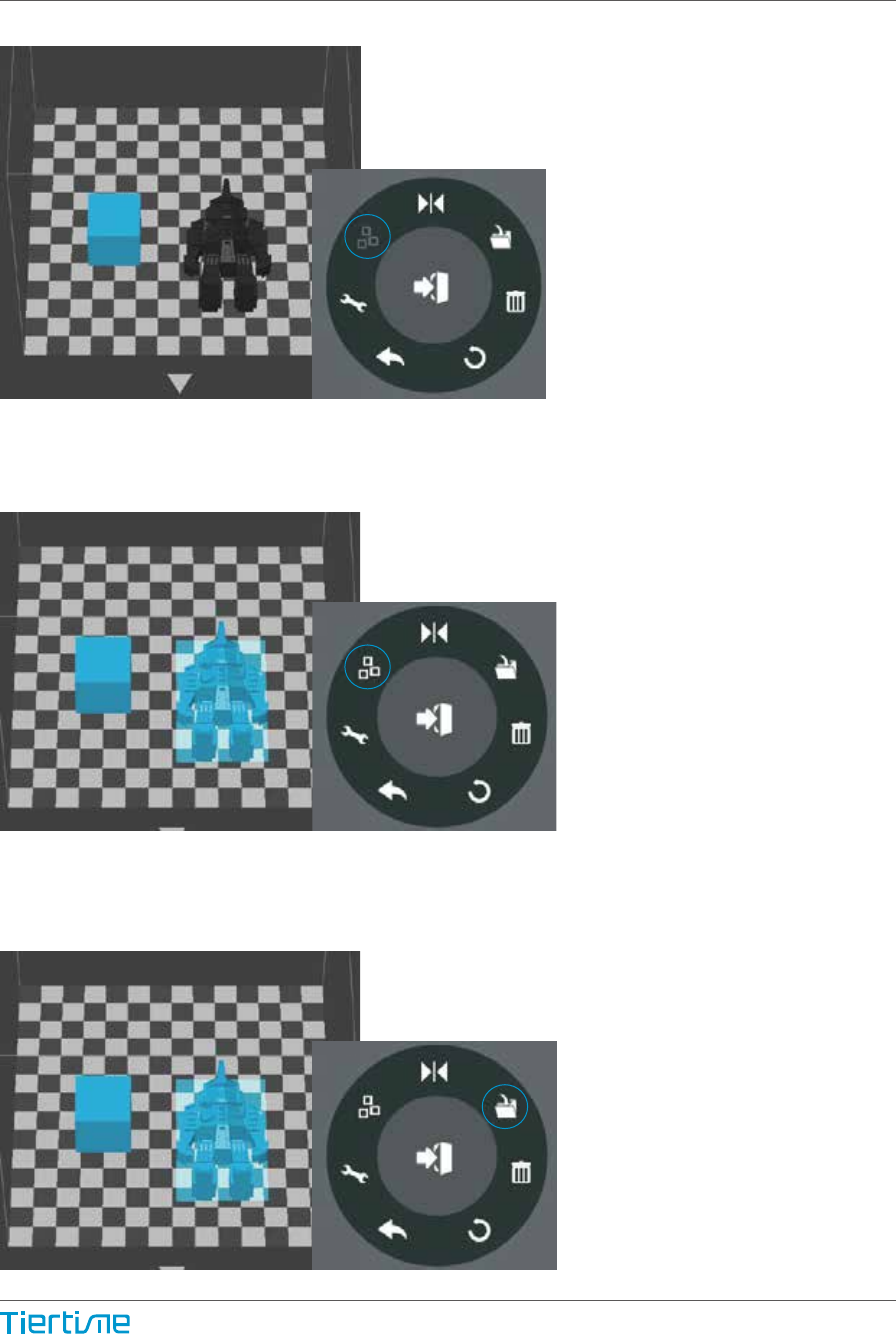
Merge and Save Models
1\ Ctrl/CMD click all the models on the
build plate.
2\ The Merge button on the second level
of the adjustment wheel will become avail-
able, click to merge the models.
3\ Click the save button to save the
merged models to comptuer.
38
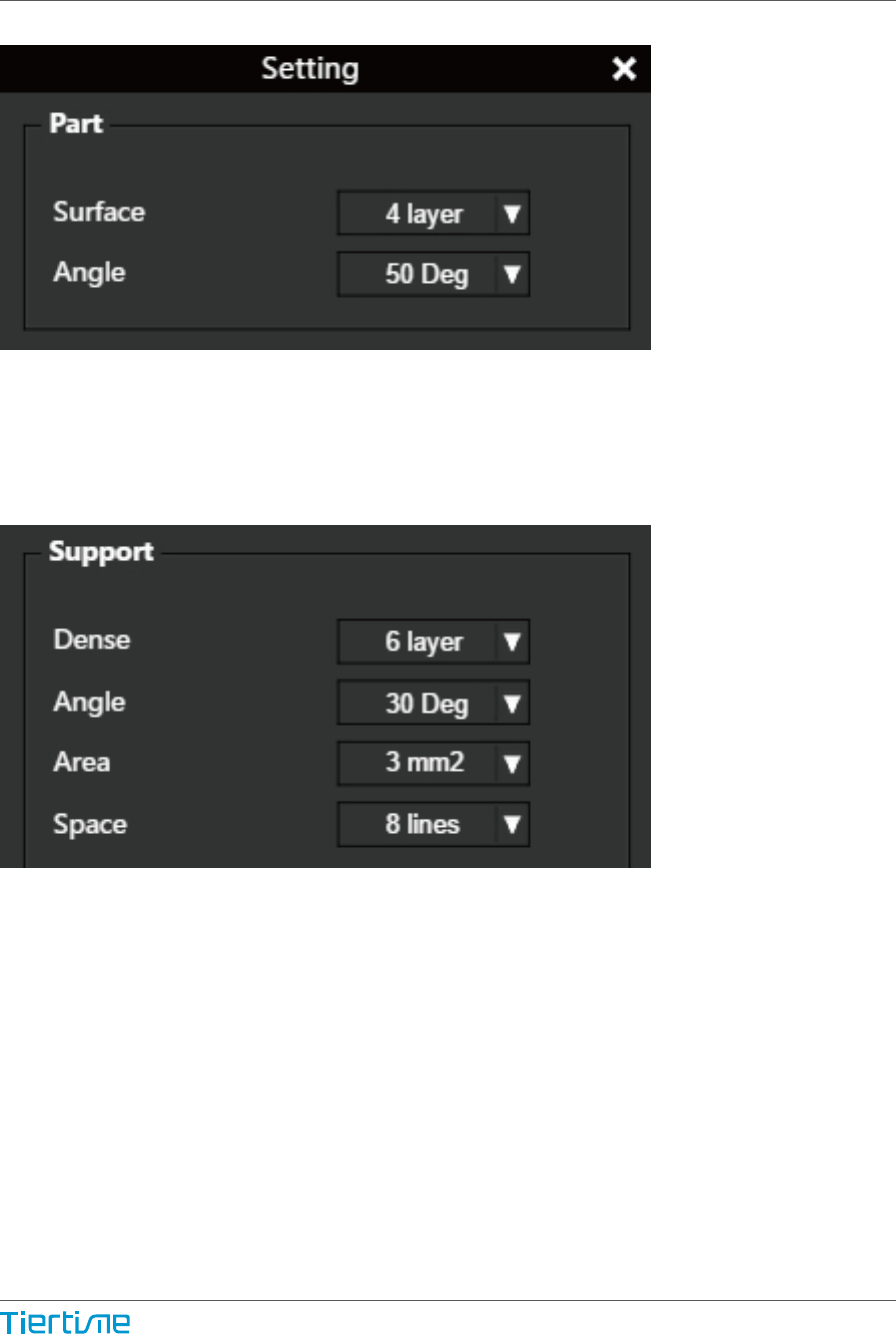
Print Preference
Surface: the number layers at the sealing the top and the bottom of the printed object.
Angle: This determine at which angle the Surface layers start to be printed.
Dense: Choose the number of dense layers between support and supported surfaces.
Angle: Determine the angle which support and dense layer to generated.
Area: Determine the minimal area of surface that will be supported, area less than this
vaule will not be supported.
Space: Determine how desne the support will be, the larger the value the less dense
of the support.
2-1
39
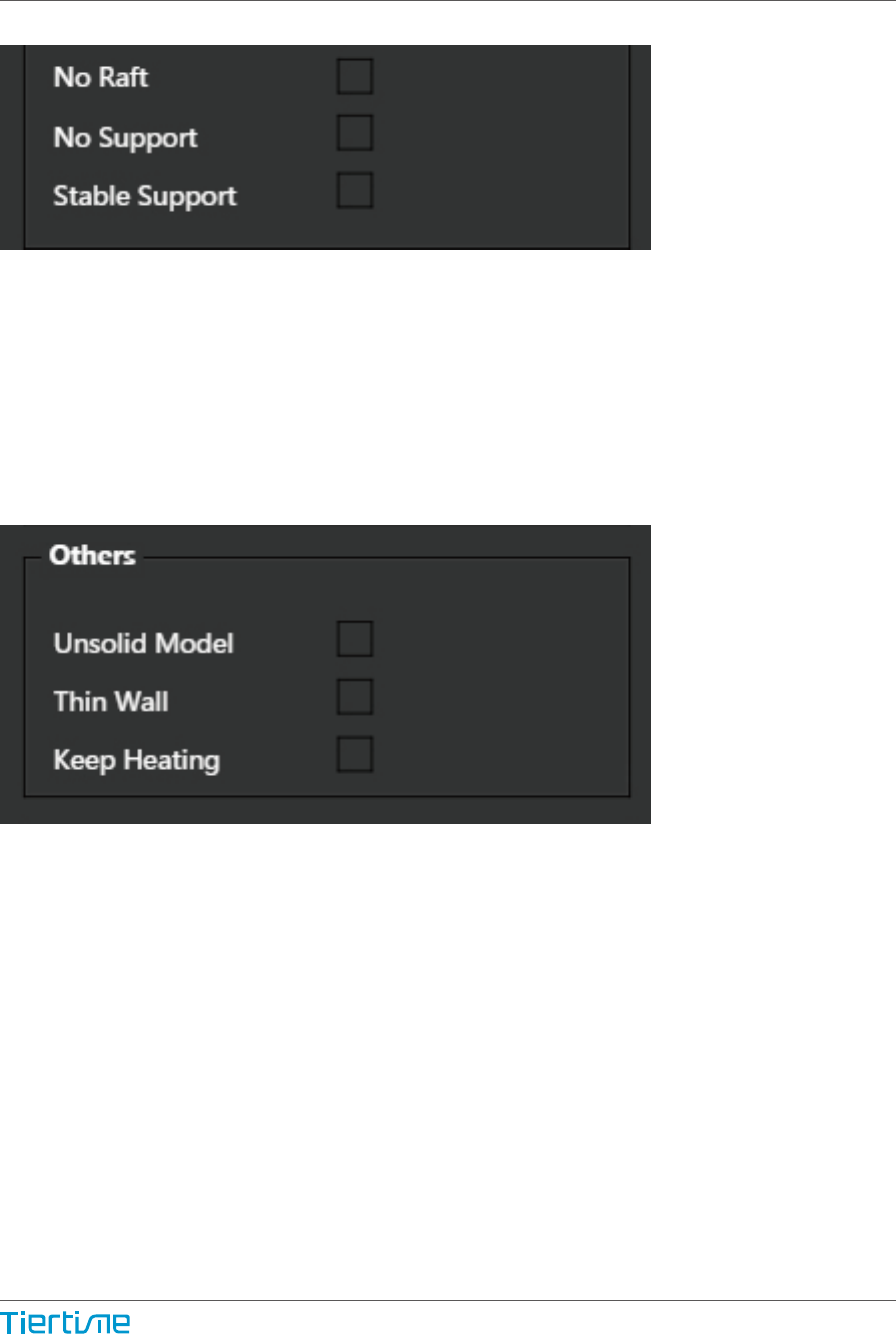
Print Preference 2-2
No Raft: print without raft.
No Support: print without support
Stable Support: Support structure will be stronger but less easy to be removed.
Unsolide Model: The software will autofix nonsolid models
Thin Wall: The Software will detect wall thickness that is too thin to print and expand
the feature to a printable size.
Keep Heating: The platform will be heated after print job is completed.
40
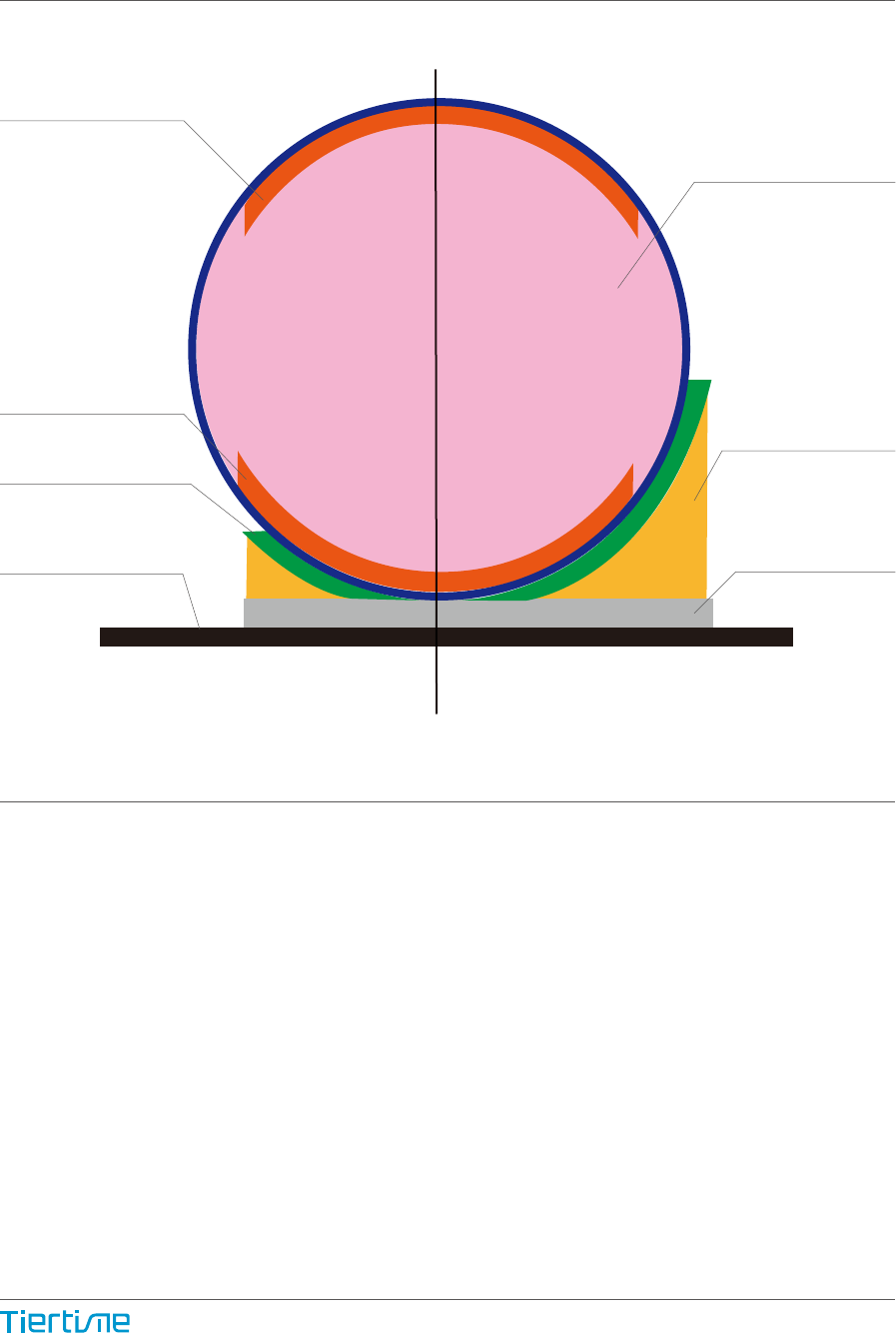
Printing Parameters
Surface
Infill
Support
Raft
Surface
Dense (support)
Print Platform
Suppot Range: < 30oSupport Range: < 90o
Dense: Solid support structure ensures that the surface being supported retains its
shape and surface finish.
Infill: The inner structure of the printed object. The density of the infill can be adjusted.
Raft: The thick structure that assists with the adhesion of the object to the plat- form.
Surface: The top and bottom layers of the printed object.
41
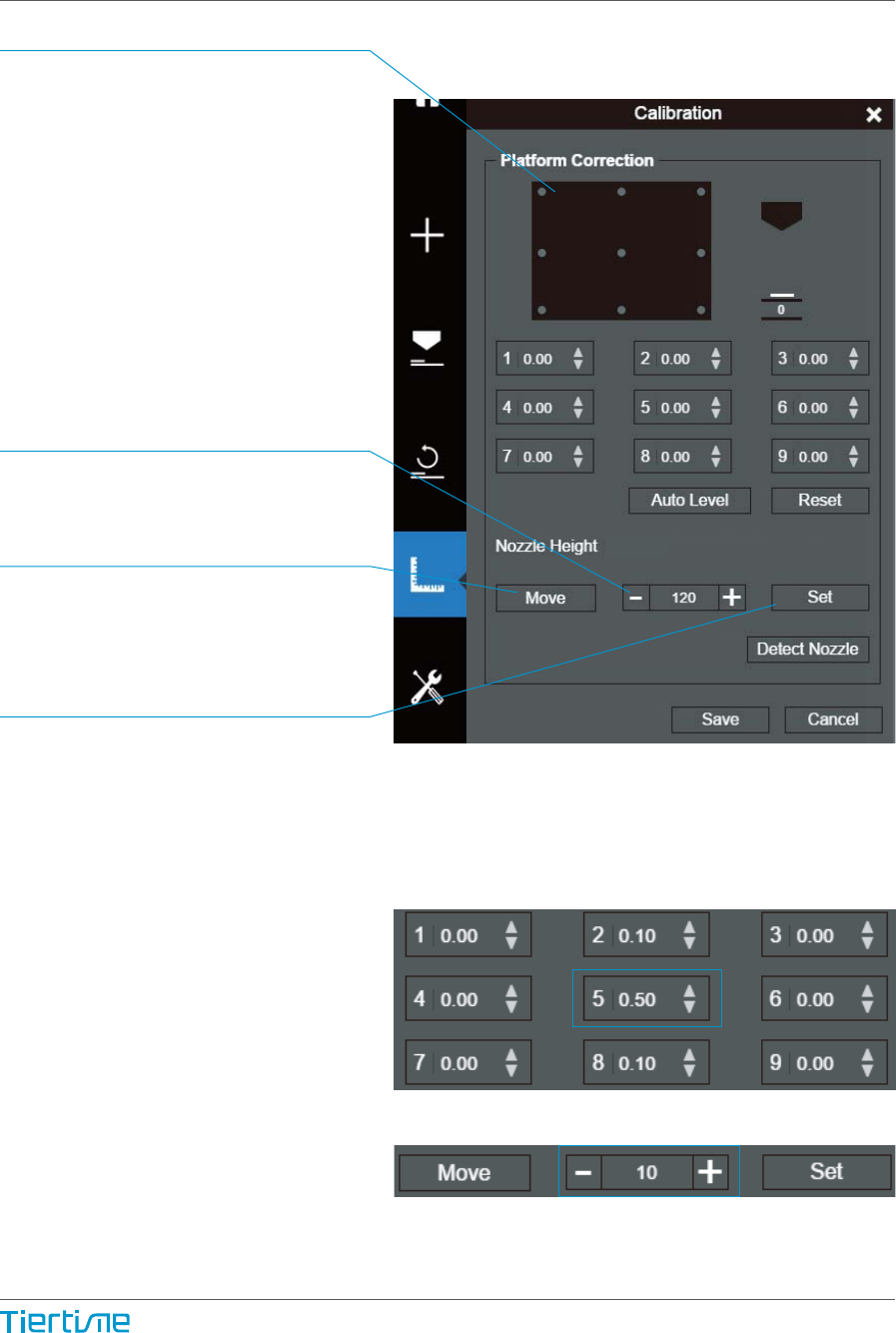
Manual Calibration
The 9 buttons represent platform
calibration point.
The dropdown menu beside the
button is for setting the leveling
compensation values. After chekc-
ing the leveling check box and click-
ing these buttons, the nozzle will
move to the corresponding posi-
tions and move up base on the com-
pensa- tion value.
Moves the platform up/down: click
the +/- buttons to move the platform
up and down.
For sending the platform to a specif-
ic height, input the value in the text
eld between + and - and then click
“Move” button.
Click "Set" button user want to save
currently platform height as nozzle
height.
So if user click the 9 buttons, the
printhead will move to correspond-
ing position and platform will move
to a height that equal to “value in the
text eld” + the “compensation value”
120.90
42
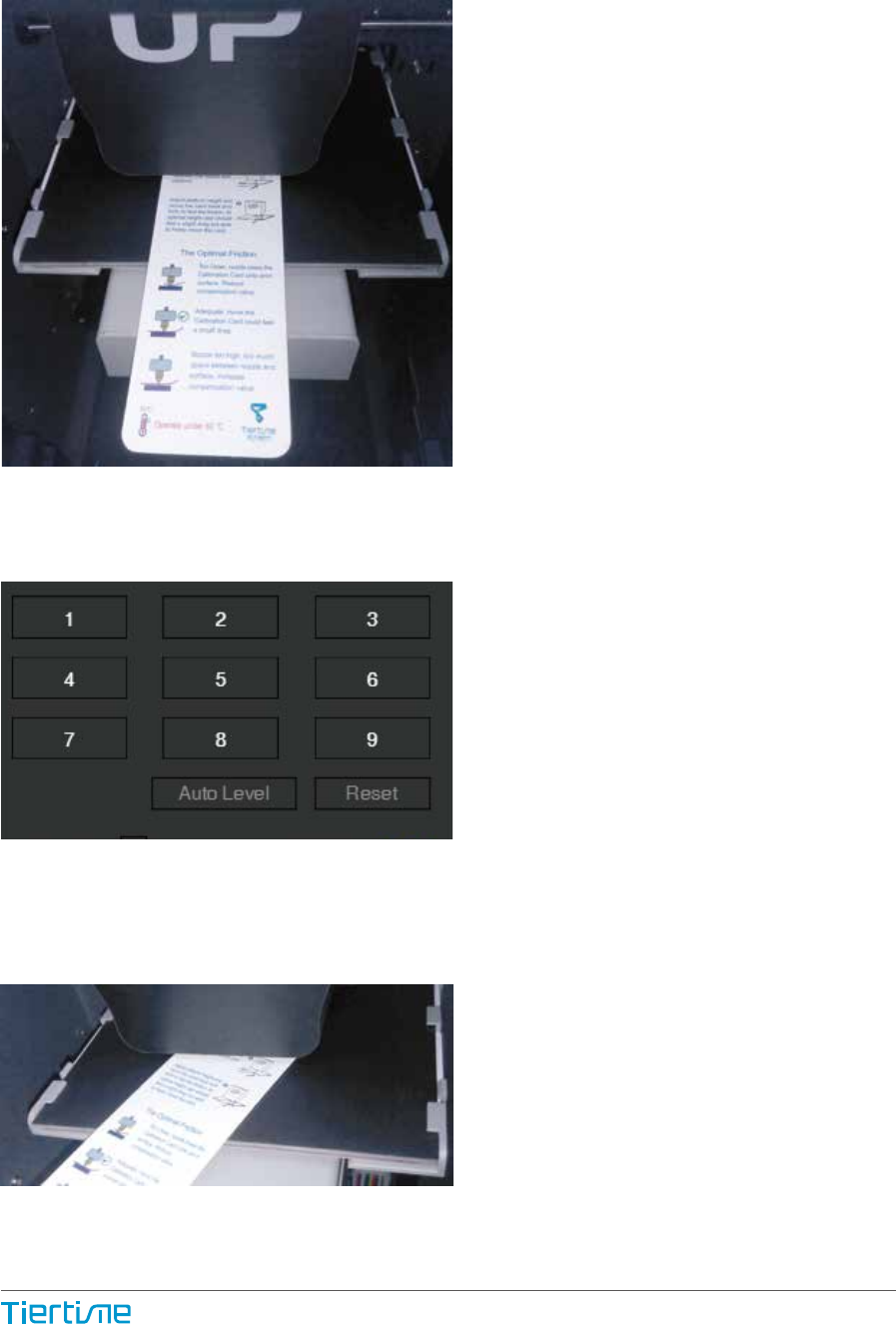
1\ Initialize the printer
2\ Put a Calibration Card on the plat-
form.
3\ Move print head to the middle of
the platform by click 5.
4\ Raise the platform until it is just
touching the nozzle. Move the Cali-
bration Card between the nozzle and
the platform to see if there is any
resistance.
43
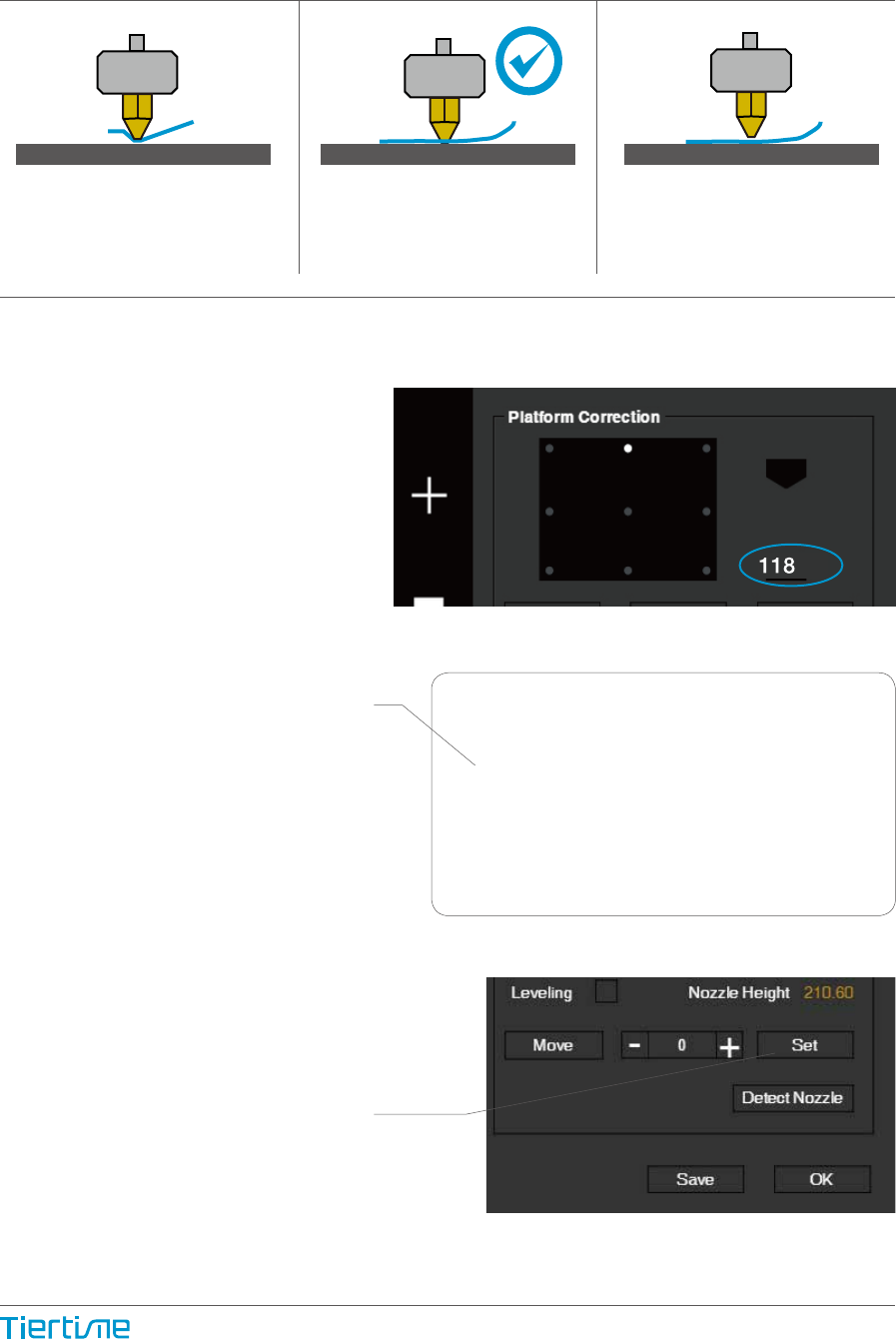
Platform too high, nozzle is
pinning Calibration Card
onto platform, Lower the
platfrom slightly.
Just right, can feel some
resistance when moving the
paper.
Platform too low, no resist-
ance at all when moving
Calibration Card, raise the
platform slightly.
5\ When the ideal platform height
is obtained, record the platform
height value. Repeat steps 1–6 for
all of the other eight positions and
note their platform height values.
6\ When you have obtained the
platform height values for all nine
positions, find the lowest value
among all the values.
In this example, the first cali-
bration point has the lowest value
and is thus the highest point on the
platform. (The highest point of the
platform re- quire minimum amunt
of travel to reach the nozzle).
7\ Move the platform to the posi-
tion with lowest platform height
value as determined in Step 7 and
click the "Set" button. This will set
this point as the "Nozzle Height".
Platform Values at 9 calibration points
(hypothetical):
1: 118
4: 118.6
7: 118.8
2: 118.5
5: 118.9
8: 118.9
3: 118.7
6: 119
9: 118.8
44
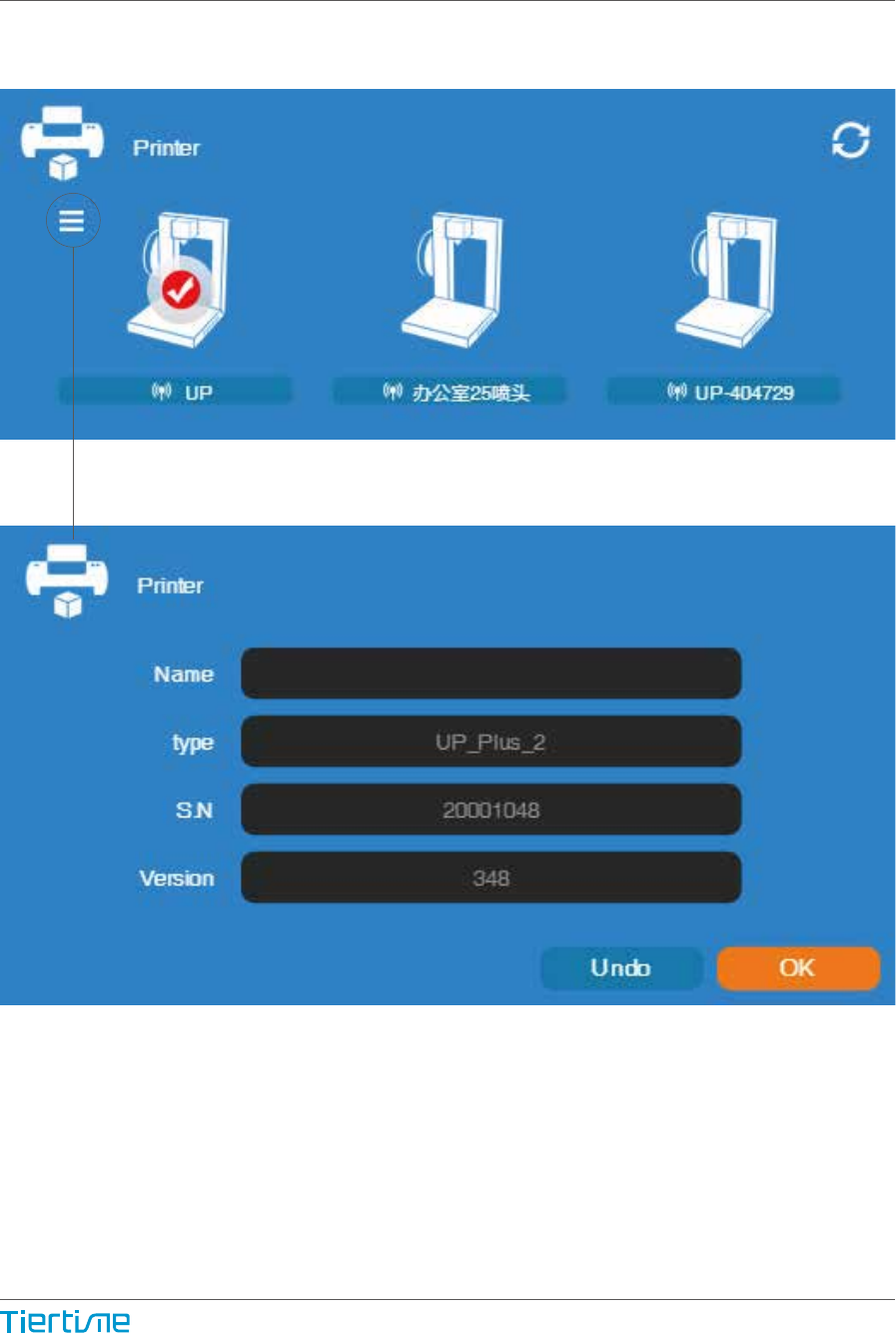
Printer Info
Printer info will be displayed by clicking the small button on the top left hand corner of
the connected printer icon. Information including printer type, serial number and firm-
ware version will be displayed. User could also set a custom name for the printer at
the name field.
45
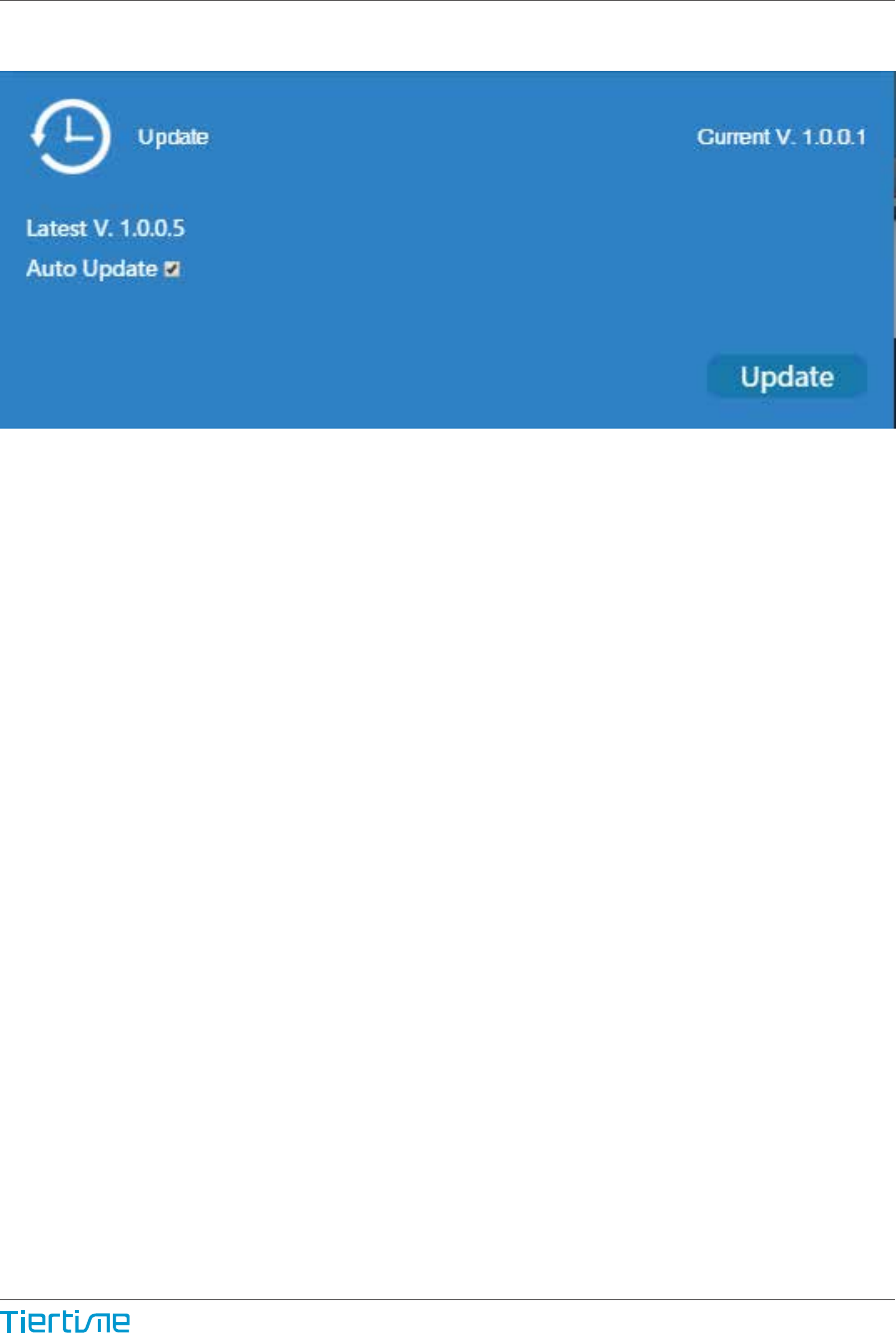
Check Auto Update to allow the software to inform user the latest version.
Software Version and Update
46
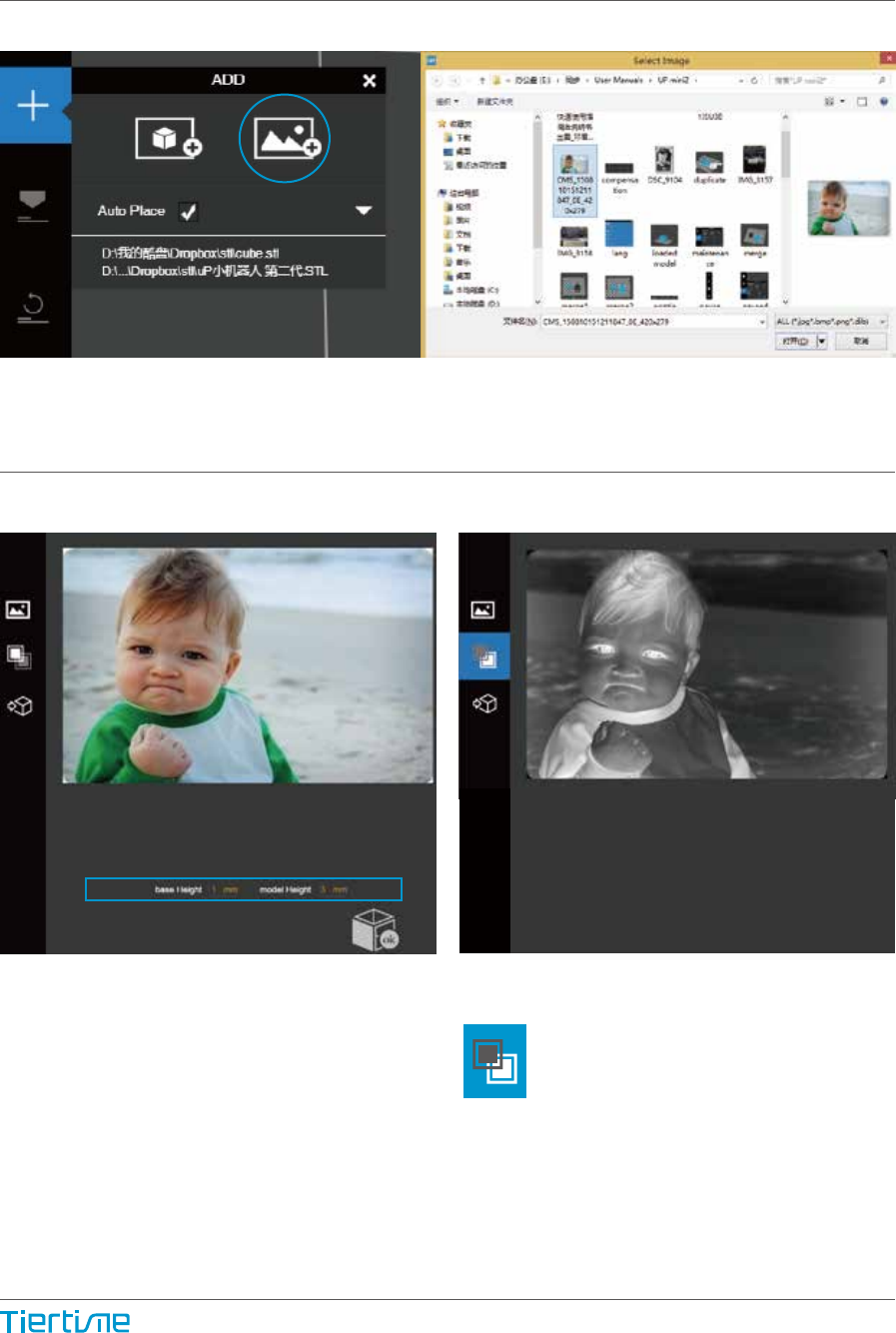
The Base height determine the thickness of
a flat layer that will hold the picture.
Model Height determine the contrast of the
finally print.
The convert negative button will reverse
the pixel intensity so that user could
choose the picture to be protruding from
or sunken into the base.
Convert Picture Into 3D Model
Click add picture button and select a picture.
2-1
47
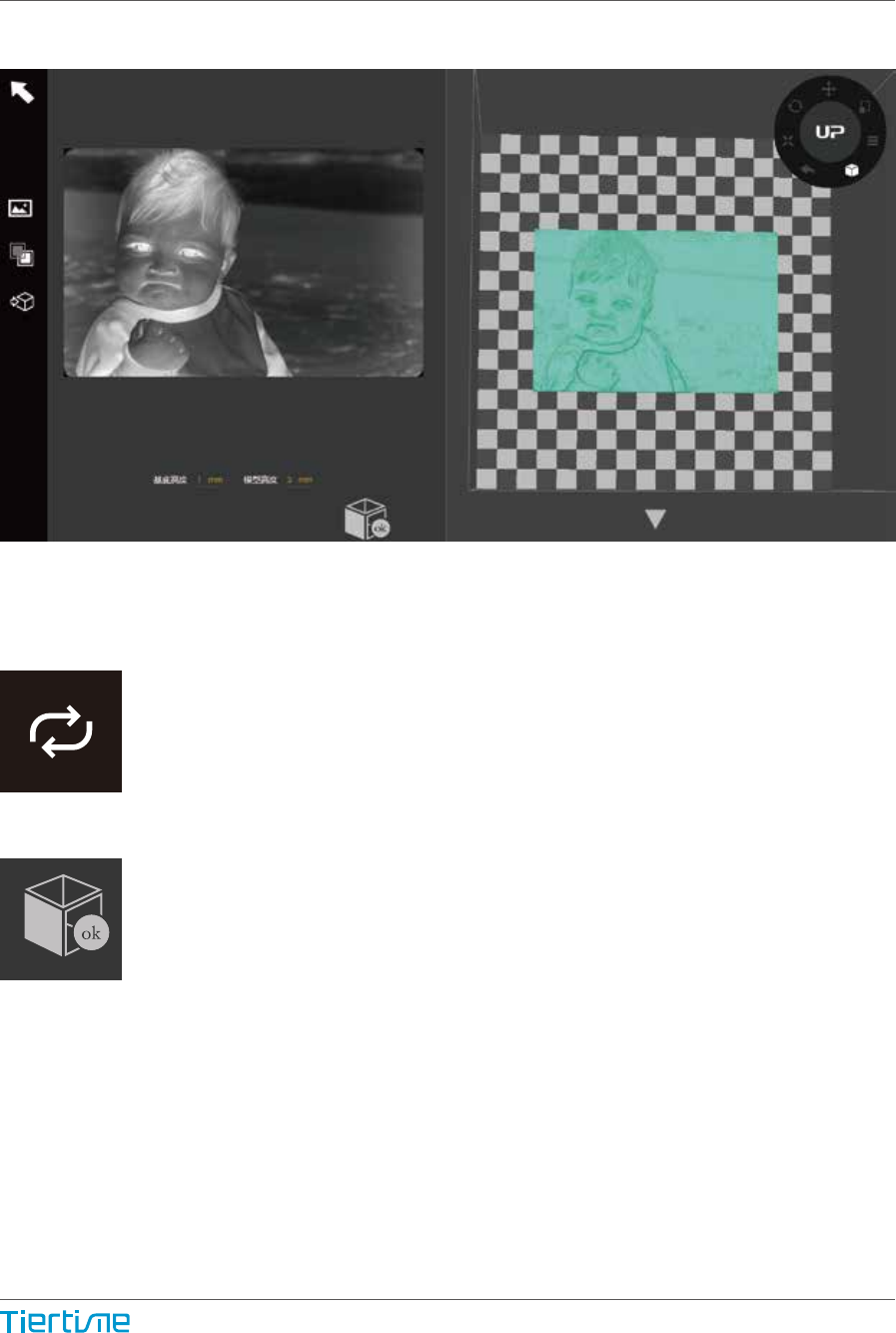
Update 3D model button. This button will convert the modi- fied picture on the left to
a 3D rendering on the right.
OK button send the 3D rendering to the 3D printing interface for printing.
Convert Picture Into 3D Model 2-2
48
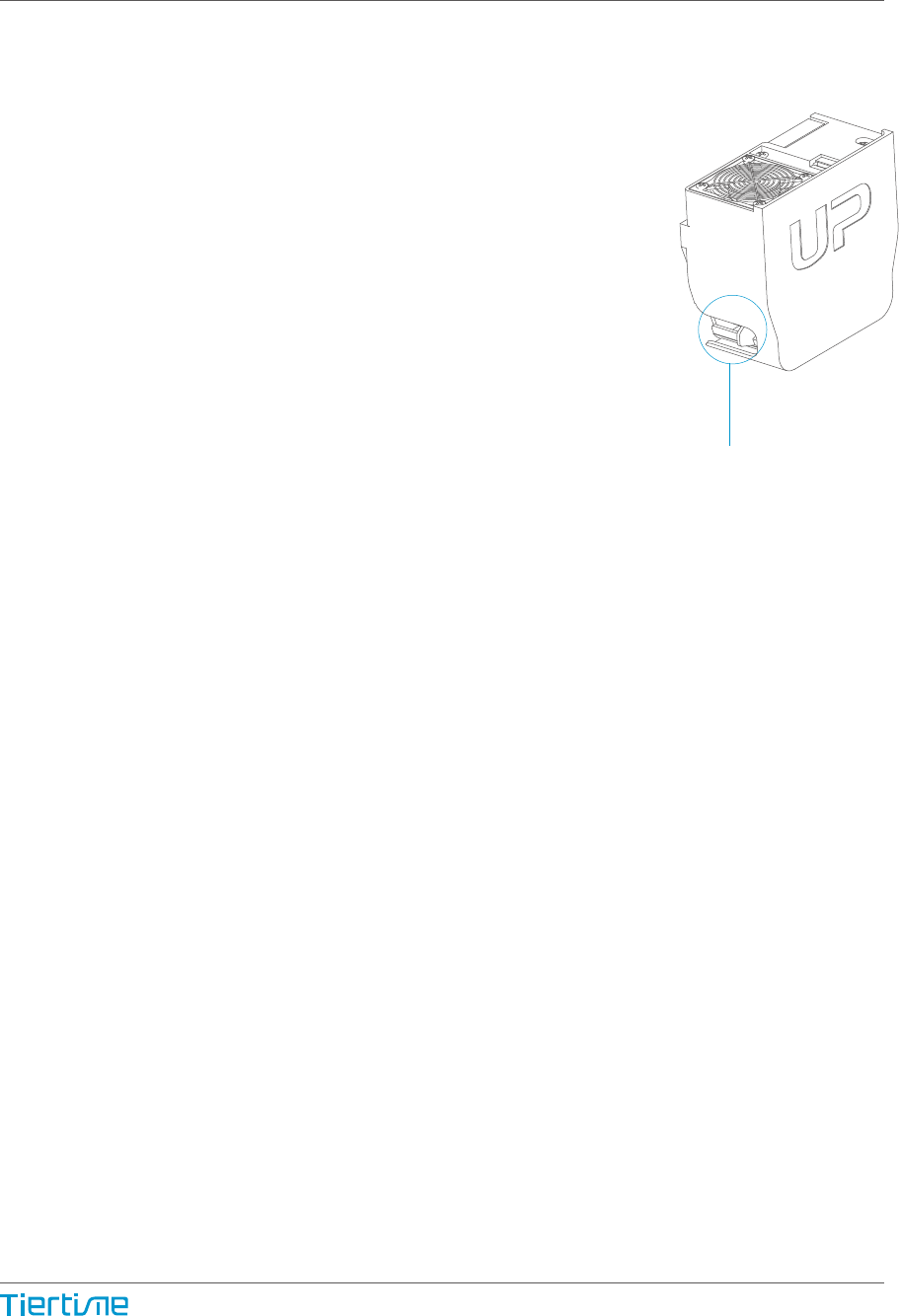
Air Flow Adjustment
knob
Printing Techniques
1. Ensure accurate nozzle height. If the nozzle height
value is too low, it will cause warping; if it is too high, it will
crash the nozzle into the platform,causing damage and
clogging. You can manually fine-tune the nozzle height
value in the"Calibation"panels.You can try to adjust the
nozzle height value plus or minus 0.1–0.2mm from the
base on previous results.
2. Calibrate the printing platform well. An unleveled plat-
form usually causes warping. Allow enough time for suffi-
cient preheating. Please usethe3DPrint–Preheatfunc-
tion.A well preheated platform is essential for printing
large objects without warping.
3. The airflow on print head is adjustable, slide the air flow
adjustment knob to change the amount of cooling of print-
ed object.Generally the more cooling provided, the better
the print quality. Cooling also help separate from support
and raft. However cooling also encourage wrapping,
especially for ABS.
To generalize, PLA can take strong cooling without prob-
lem,while ABS should avoid cooling or give little cooling.
For ABS+ medium cooling is recommended.
4. Printing with no raft. It is highly recommended to use
raft for normal printing as it improves adhesion and is
required for leveling compensation. It is turned on by
default, but you can turn it off in the "Print Preference"
panel.
5. Printing with no support. It is possible to print with out
supporting structures.You can turn off support by choos-
ing "No Support" in the "print" setting panel.
49
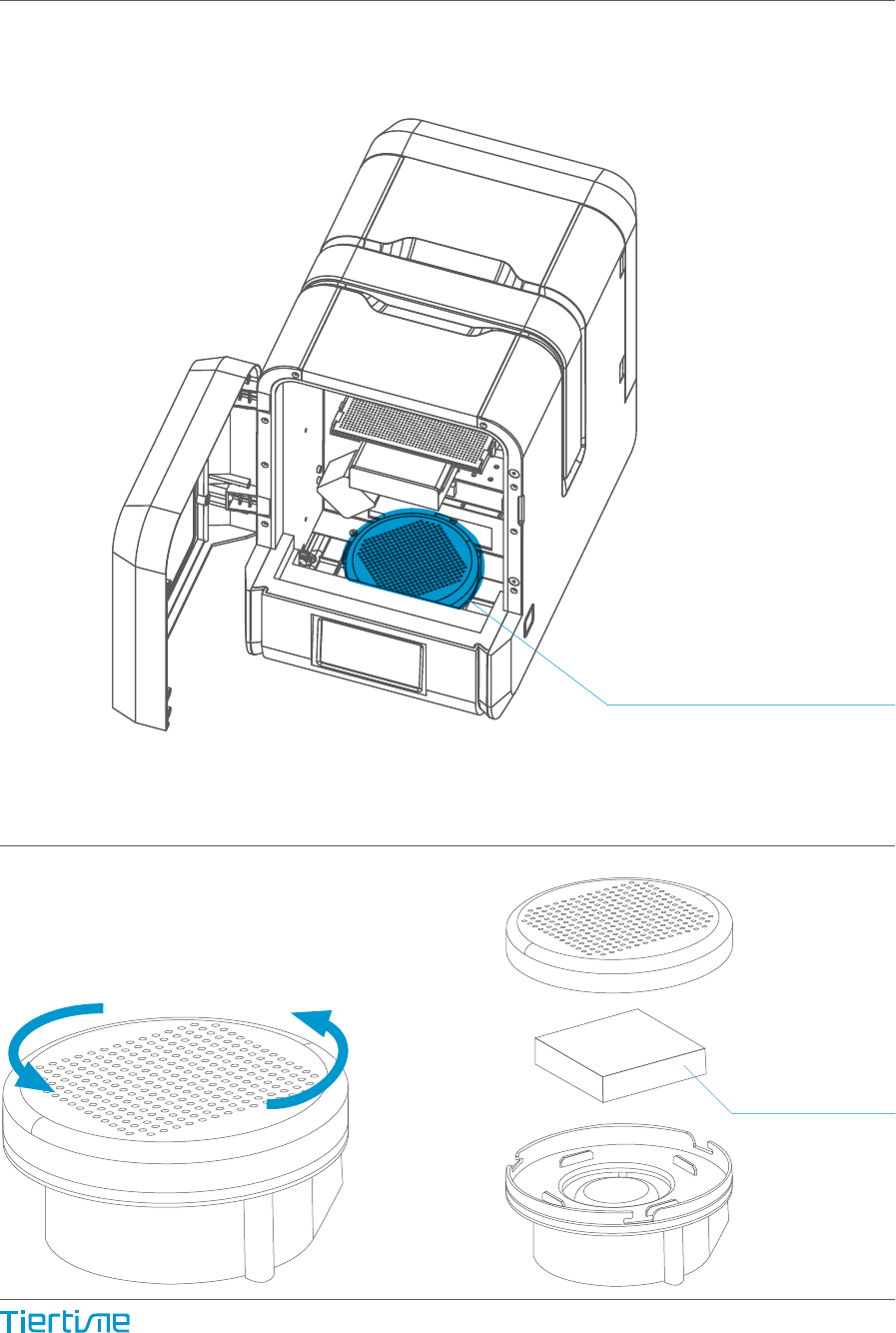
Air Filtration Unit
HEPA-Filter
Front View
Turn anti-clockwise to
open the cap.
Printer Maintenance - Air Filter Replacement
Change air filter for air filatraton unit. It is recommmended to change the filter for
every 300 hours of usage or 6 months.
50
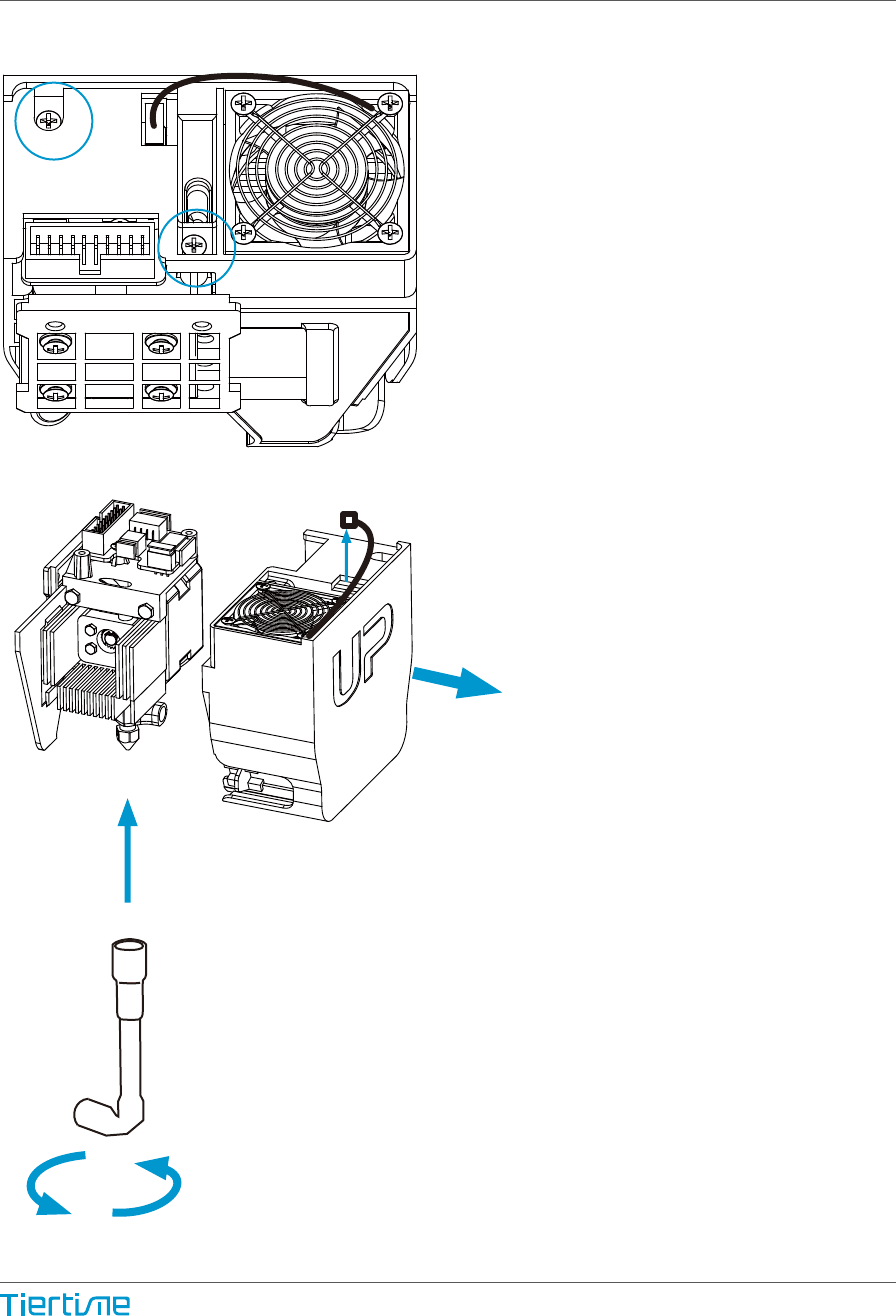
Heat up the nozzle to printing temperature by using the
extrude function in maintenace interface.
Nozzle could be removed by using the nozzle wrench
provided.
User does not need to remove printhead cover in order to
remove nozzle.
The printhead cover could be removed
after unscrew 2 bolts.
Print Head Maintenance
51
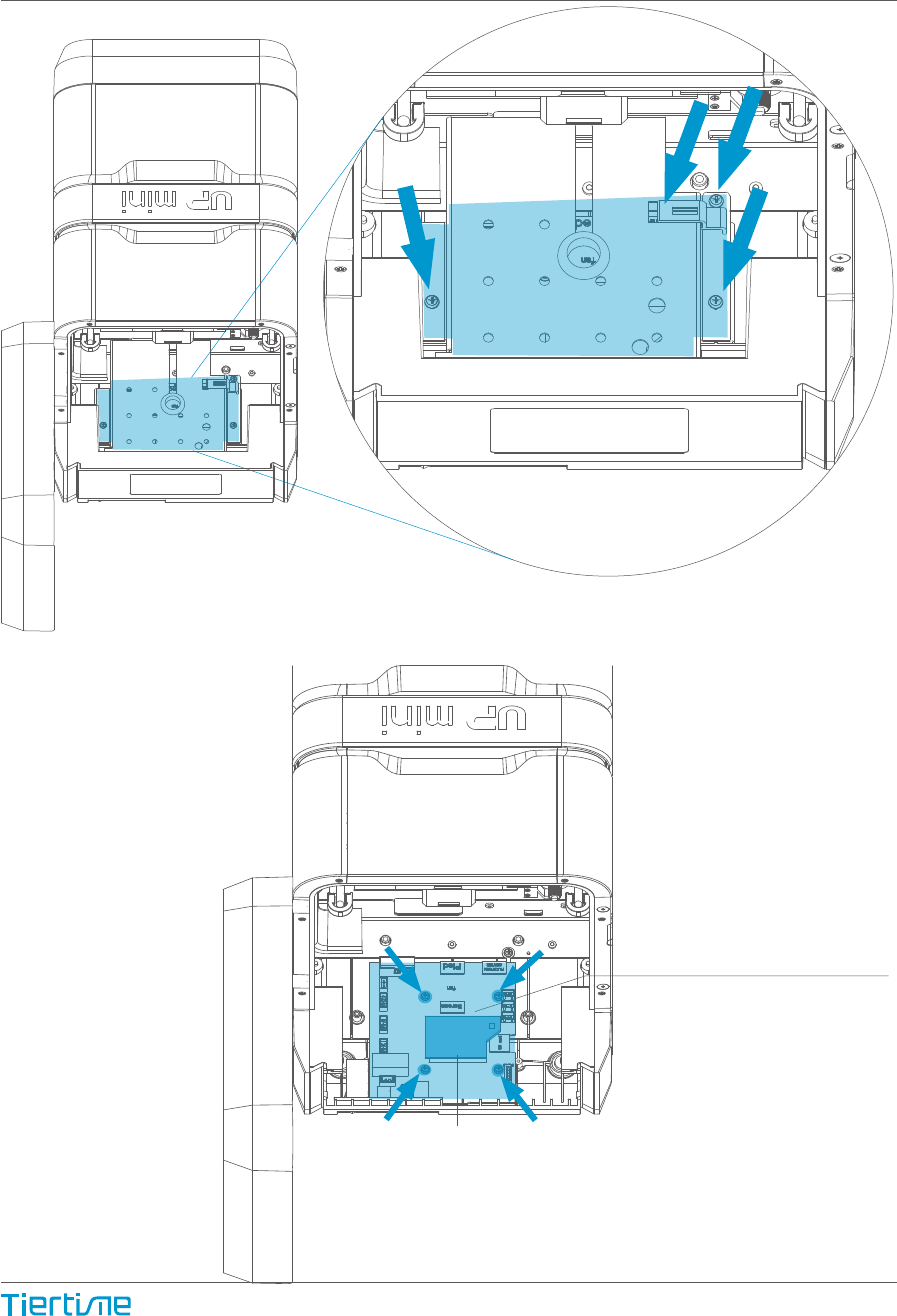
Remove the 3 screws and FFC cable clip on the
mainboard cover.
Mainboard
CPU
Printer Maintenance - remove motherboard cover
52

Beijing Tiertime Technology Co., Ltd
youtube.com/c/UP3DPrinters
facebook.com/up3dp/
instagram.com/up3dprinter/
twitter.com/UP3DP
Support Eamil: support@pp3dp.com Web: www.tiertime.com
This equipment has been tested and found to comply with the limits for a Class B digital device,
pursuant to part 15 of the FCC Rules. These limits are designed to provide reasonable protection
against harmful interference in a residential installation. This equipment generates, uses and can
radiate radio frequency energy and, if not installed and used in accordance with the instructions,
may cause harmful interference to radio communications. However, there is no guarantee that
interference will not occur in a particular installation. If this equipment does cause harmful
interference to radio or television reception, which can be determined by turning the equipment
off and on, the user is encouraged to try to correct the interference by one or more of the
following measures:
• Reorient or relocate the receiving antenna.
• Increase the separation between the equipment and receiver.
• Connect the equipment into an outlet on a circuit different from that to which the receiver is
connected.
• Consult the dealer or an experienced radio/TV technician for help.
Caution: Any changes or modifications to this device not explicitly approved by manufacturer
could void your authority to operate this equipment.
This device complies with part 15 of the FCC Rules. Operation is subject to the following two
conditions: (1) This device may not cause harmful interference, and (2) this device must accept
any interference received, including interference that may cause undesired operation.
The device has been evaluated to meet general RF exposure requirement.
This equipment complies with FCC radiation exposure limits set forth for an uncontrolled
environment.
This equipment should be installed and operated with minimum distance 20cm between the
radiator & your body.